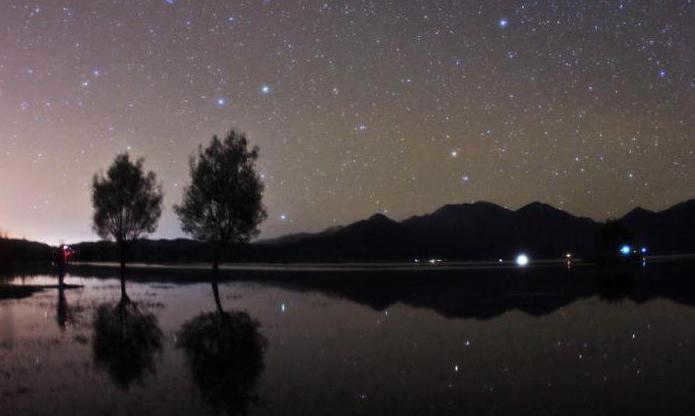

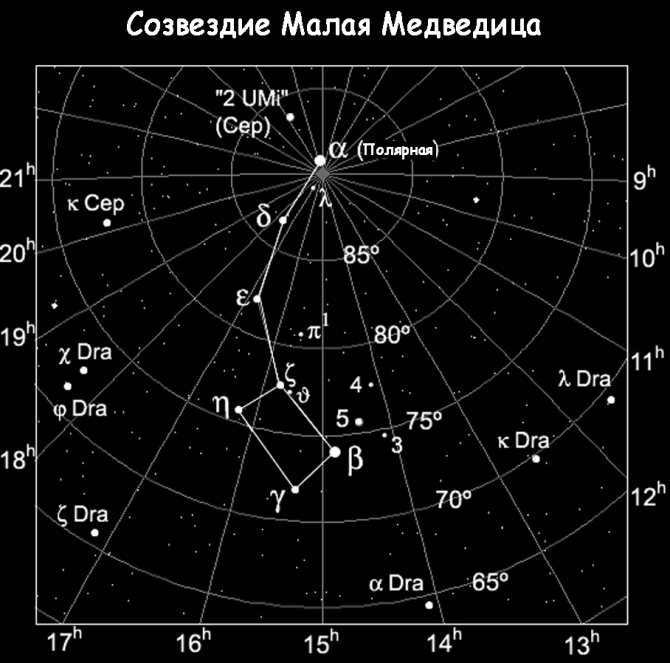
The Ursa Minor is a constellation situated in the northern sky and it derives its name from the Latin term “Ursa Minor” which means “lesser bear”.
The Ursa Minor constellation made its appearance in the night sky during the second century, all thanks to Ptolemy. It can be easily identified by its popular asterism or its position at the north celestial pole. Polaris can be seen at the tip of the dipper’s handle.
While Ptolemy is credited with recording it, Thales of Miletus (who lived between 625 and 545 BC) is believed to be the creator. He was one of the 7 Greek sages. However, there is another version that suggests he merely introduced it to the Greeks after discovering it from the Phoenicians, who utilized a similar instrument for navigation. The Greeks initially referred to it as the Phoenician instrument before it eventually became known as the Little Bear (previously known as the Tail of the Dog).
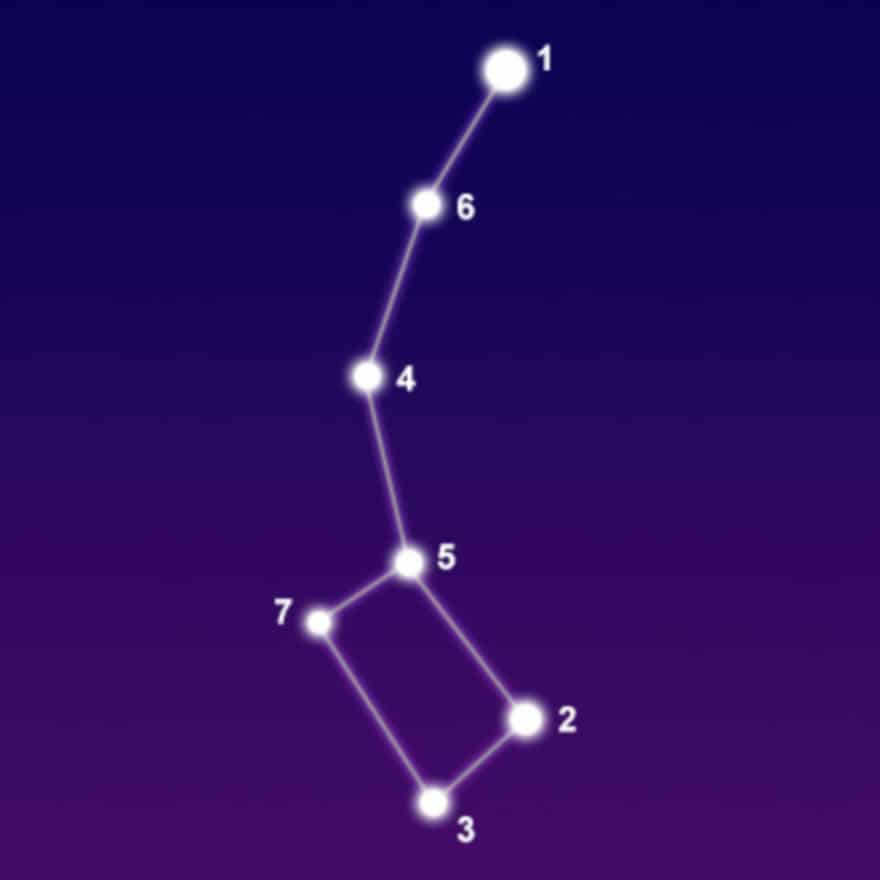
Place
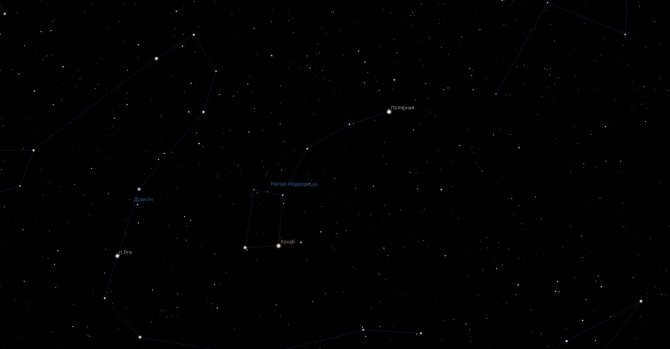

The Stellarium planetarium program provides a visual representation of the constellation of the Little Dipper.
Locating the constellation in the night sky is a straightforward task. It is situated near the Giraffe, Dragon, and Cepheus constellations. However, it is commonly found by using the Big Dipper as a reference point. By connecting the two outer stars of the Big Dipper’s ladle and measuring five times the distance between them, you can locate Polaris, which marks the beginning of the “handle” of another, smaller ladle. This smaller ladle is the Little Dipper. While not as bright as the Big Dipper, it is still clearly visible and easily distinguishable from other constellations. In the Northern Hemisphere, the Little Dipper can be seen throughout the year.
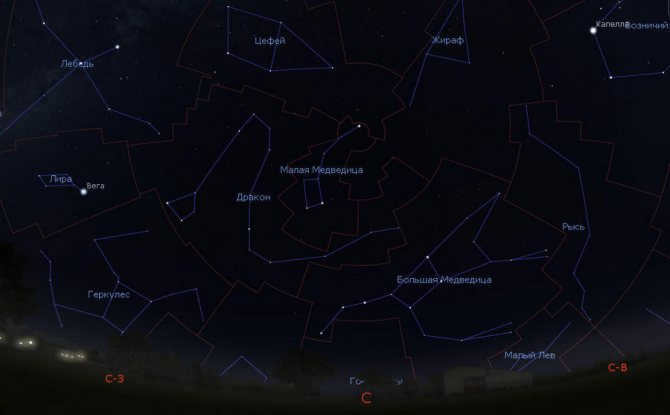
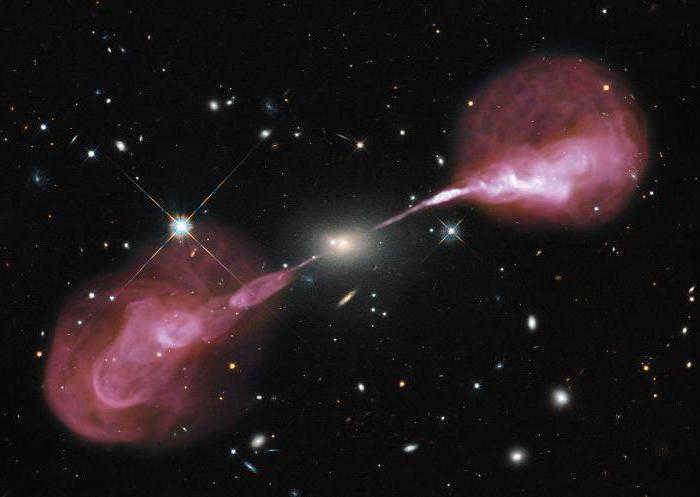
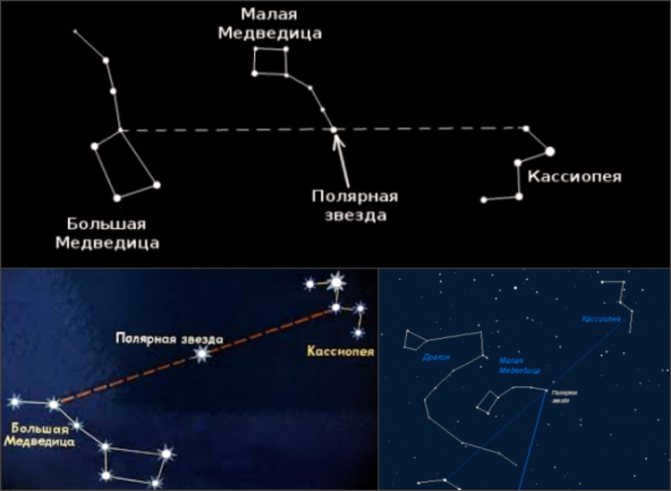
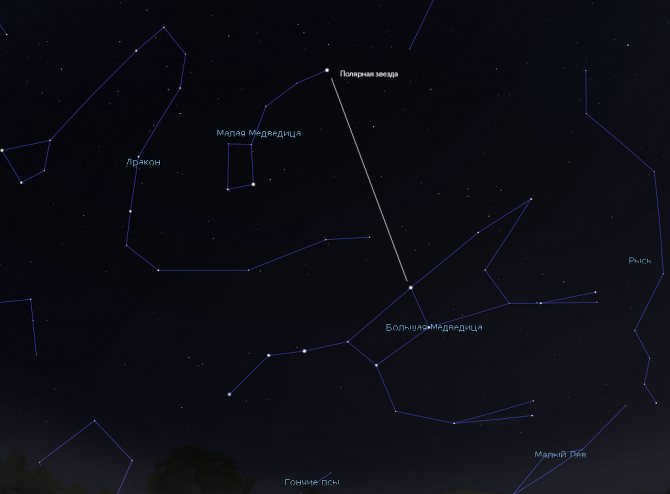
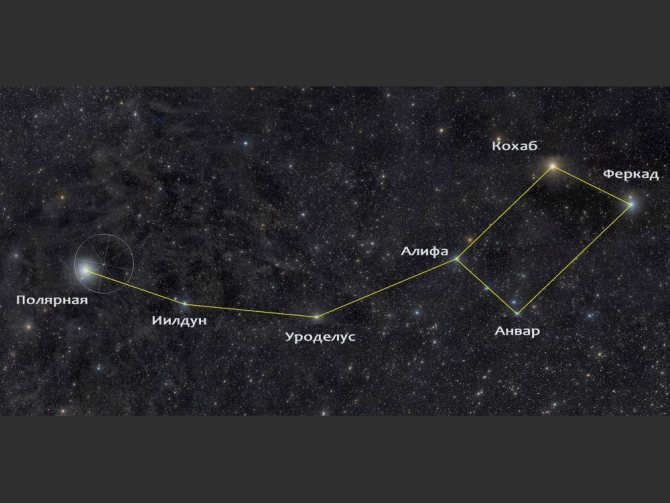
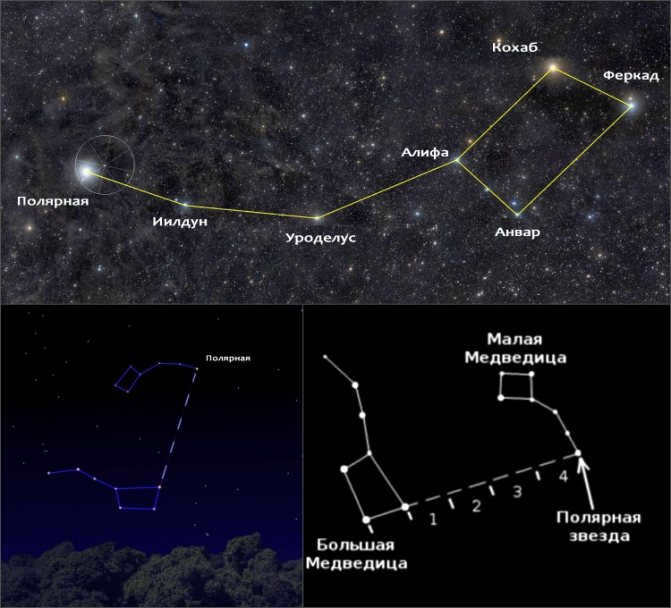
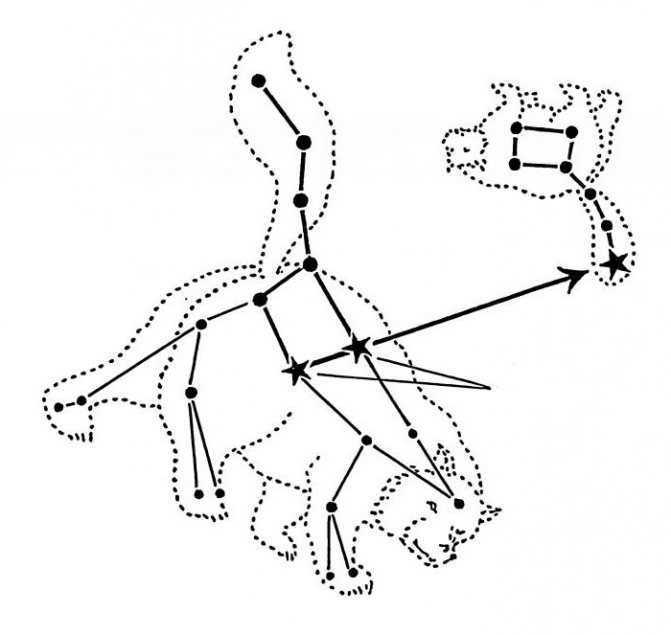
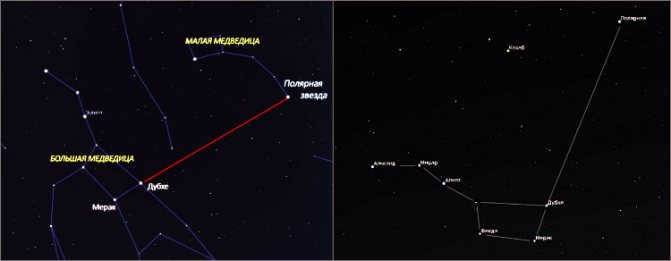
What is the method for locating the Little Bear near the Big Dipper?
It’s quite easy to locate the Big Dipper as it is a prominent and bright constellation. Since the Little Bear is close to the Big Dipper, finding it becomes clearer. To find the Little Bear near the Big Dipper, you can mentally connect the last two stars of the Big Dipper, which are Merak (β) and Dubhe (α), and extend this line upwards by a distance that is five times the distance between them. By following this step, you will be able to locate the Alpha (Polaris) of the Little Bear constellation.
Instead of wondering how to find the Little Bear constellation solely based on the location of Polaris, it is important to understand the shape formed by the stars and how the asterism is positioned in relation to the Big Dipper.
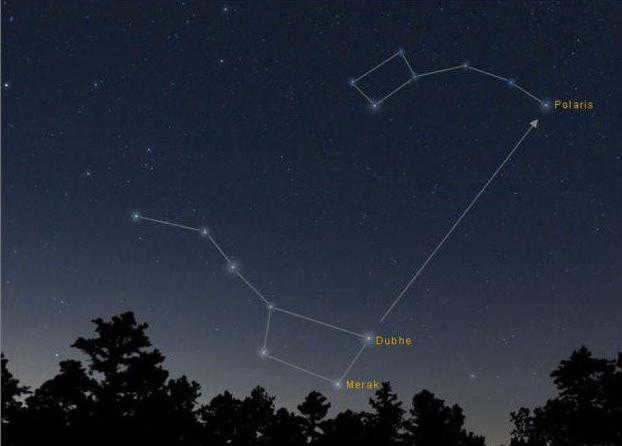
In order to gain a complete comprehension: based on their respective appellations, they possess a certain degree of resemblance and exhibit a configuration reminiscent of a receptacle. Concerning their spatial arrangement, the Little Bear occupies a nearly inverted orientation in relation to the Big Dipper.
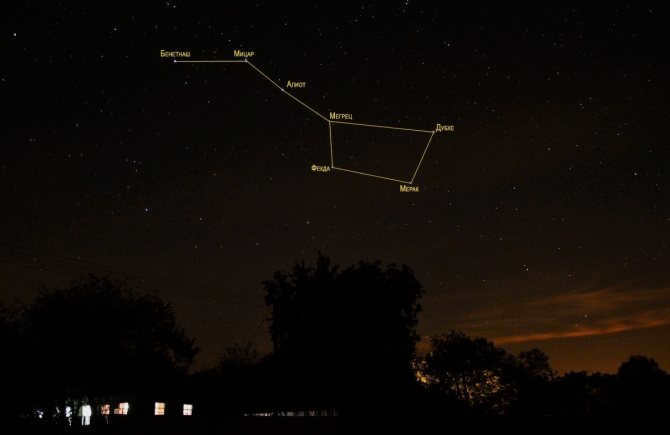
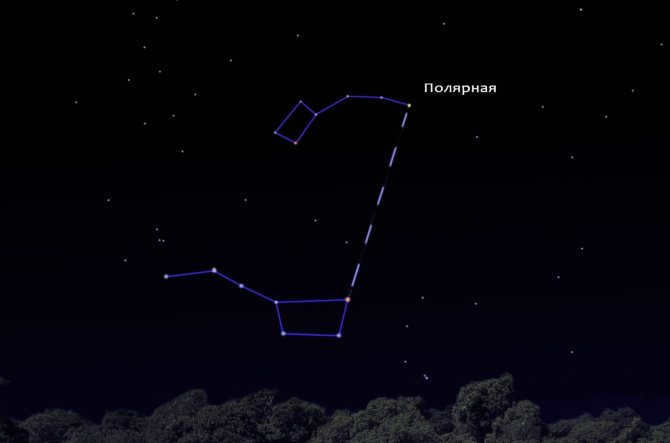
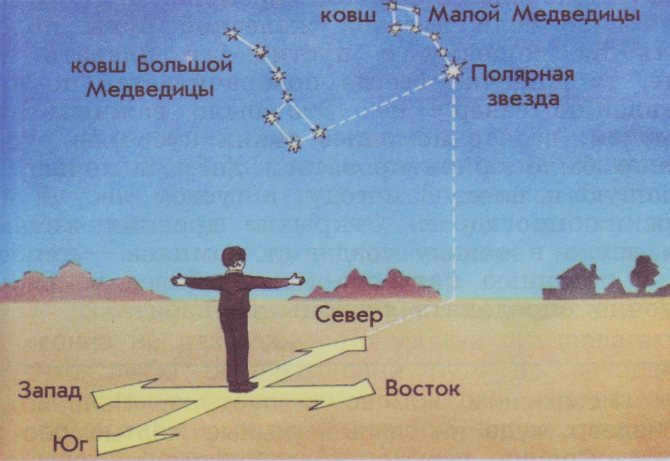



Location of Ursa Minor Constellation
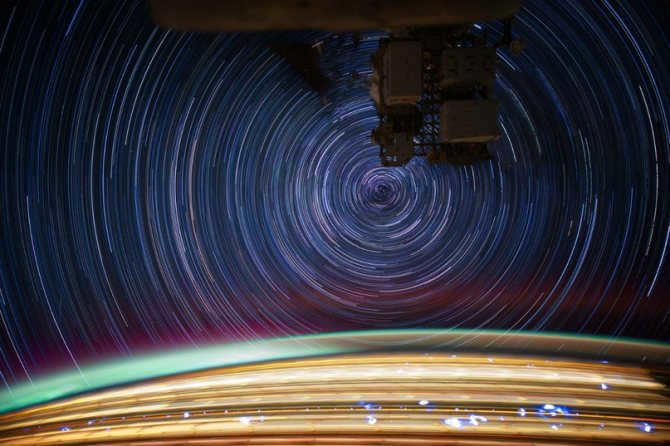
Long exposure photo taken with the camera pointed at the North Star
The North Star, also known as Polaris, is a fixed point on the celestial sphere that appears stationary to observers on Earth while other objects appear to revolve around it. It serves as a reliable reference point since its position does not change with the time of day. Although the North Star does move slightly due to the Earth’s motion, this movement is negligible over the span of centuries. Currently, Polaris is the closest star to the North Pole, deviating from it by only 40 angular minutes in calculations.
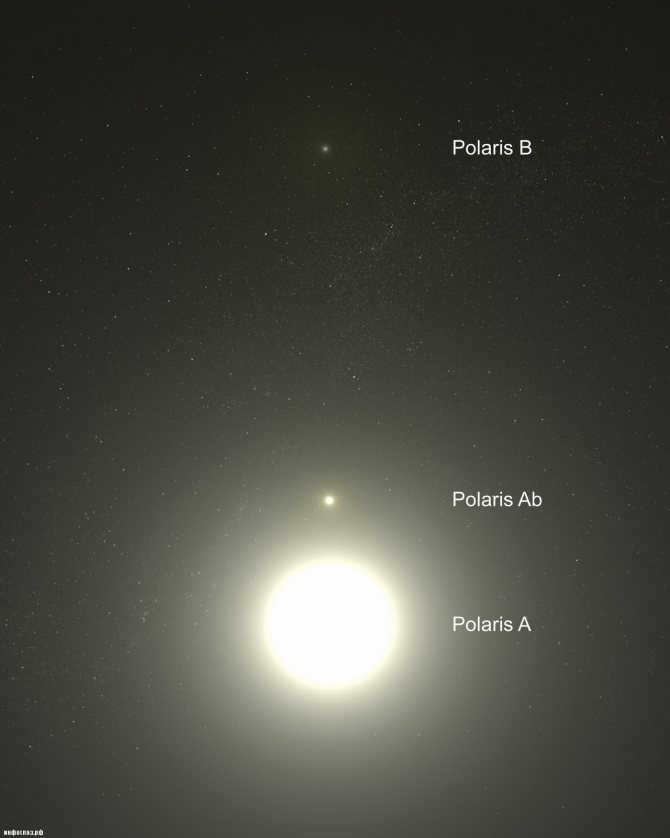
A photograph of the Polaris system is displayed here.
The star known as Alpha of the Little Bear is situated 434 light-years away from our planet and possesses an apparent magnitude of 1.97. However, it is not a single star, but rather a system consisting of three stars. The largest star in this system is 4.5 times more massive than our Sun and is also two thousand times brighter. The second largest star is located at a considerable distance from the main star and can even be observed with a small telescope. Its mass is approximately 1.39 times that of our Sun. The third star is situated so close to the first star that they can only be visually separated using the Hubble Telescope, and even then, it is a challenging task. This third star is 1.25 times heavier than our Sun.
Cohab
can be rephrased as “Living together” or “Sharing a living space”.
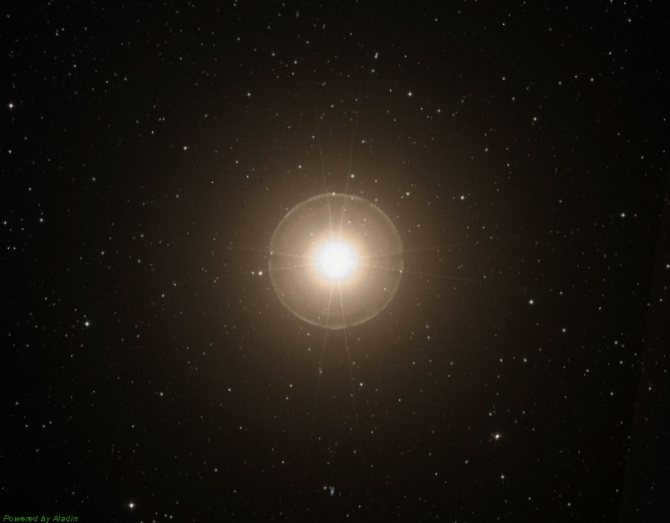
The beta star of the Little Bear, which has a magnitude of 2.08, is the second brightest star in the constellation. It is located approximately 126 light-years away from Earth. Its name, translated from Arabic, means “Star of the North”. During a period of time before our era, from around 2000 to 500 years, Kohab was the closest star to the pole and was used as a navigational reference point by the people of that time. In 2014, Korean astronomers discovered a planet with a mass 6.1 times greater than Jupiter orbiting this double star. The gas giant has an orbital period of 522.3 days.
Fercad
can be paraphrased as “Fercad is a unique individual.”
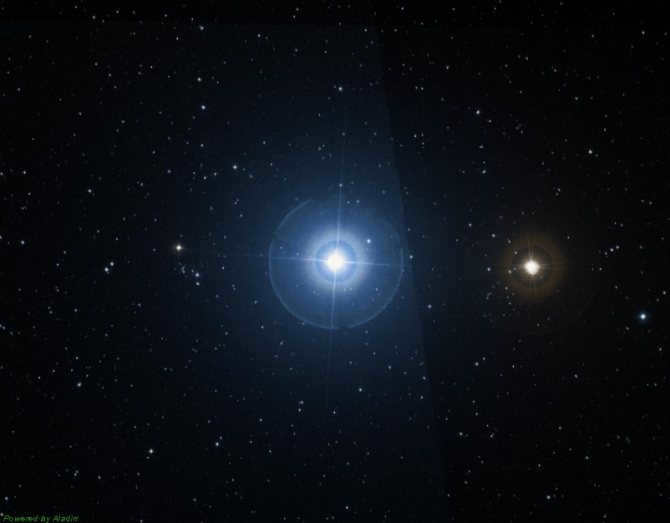
Gamma of the Little Bear is situated approximately 480 light-years distant from our planet and exhibits an apparent magnitude that fluctuates between 3.04 and 3.09. The luminary’s brightness undergoes a periodic variation with a duration of 3.43 hours. Positioned as the third most brilliant celestial object within the constellation, this entity takes the form of a hot giant possessing a temperature of approximately 8600 K. Its luminosity surpasses that of the sun by a factor of 1.1 thousand, while its physical dimensions are 15 times greater than those of our yellow dwarf. This particular luminary falls under the classification of T Shield variable luminaries.
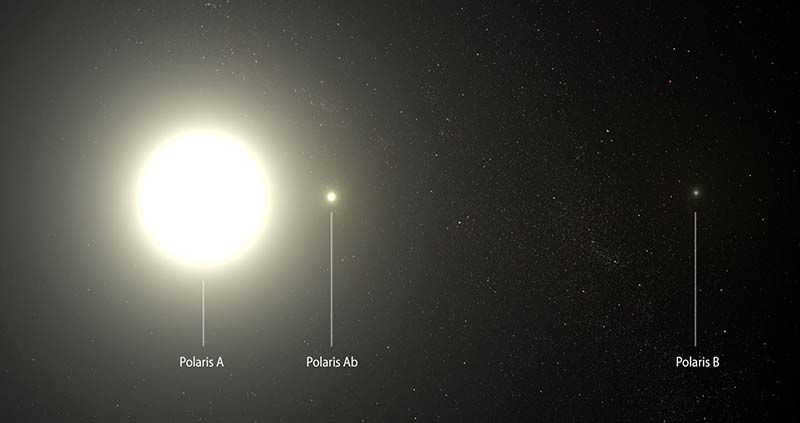
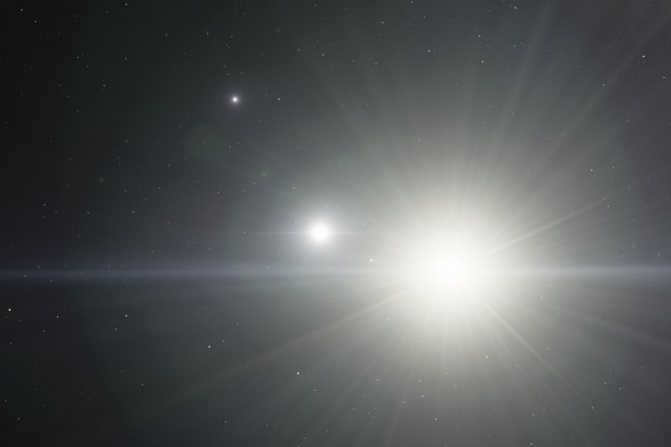
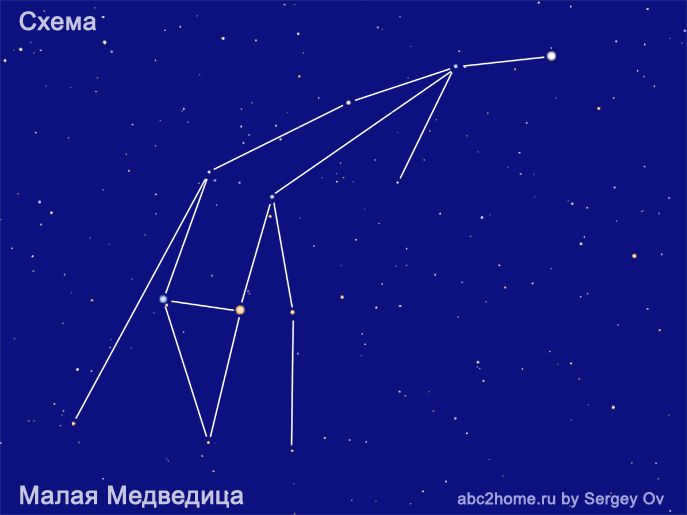
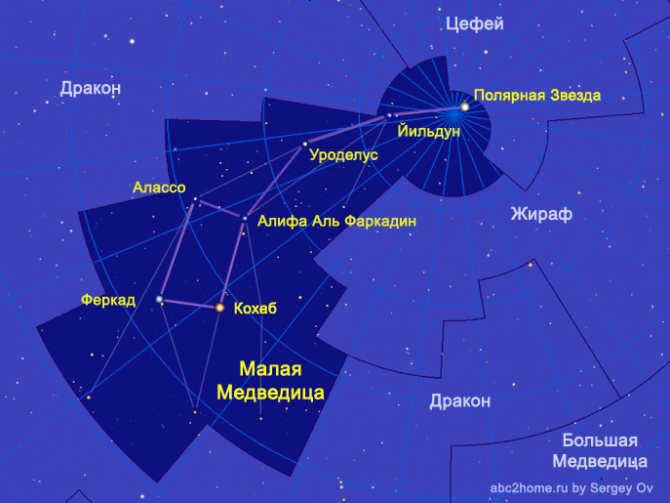
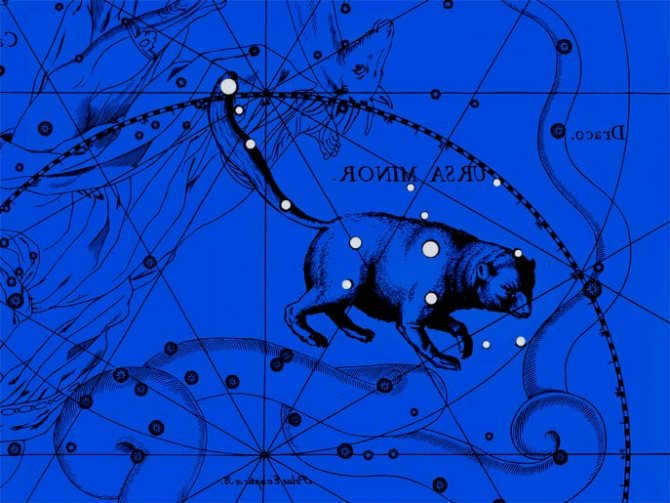
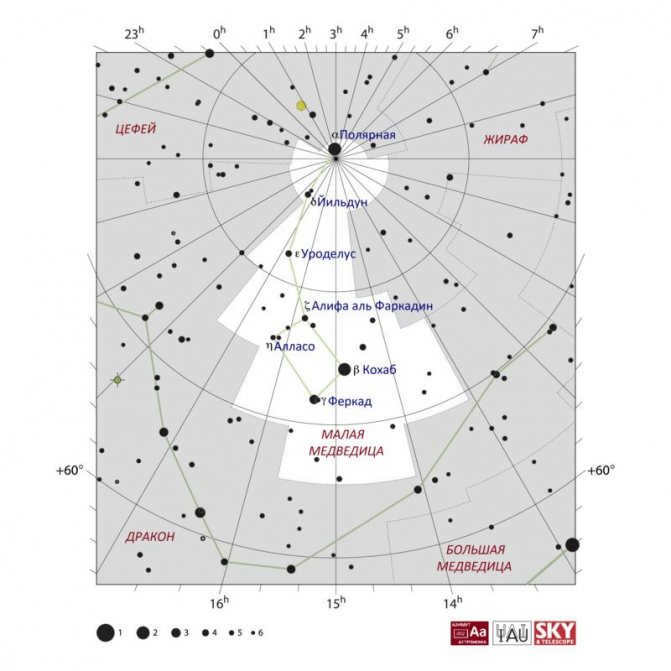
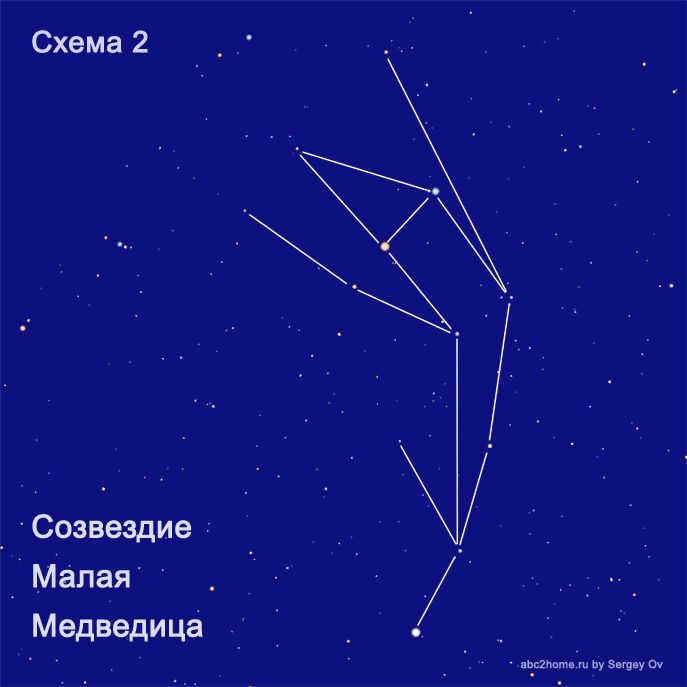
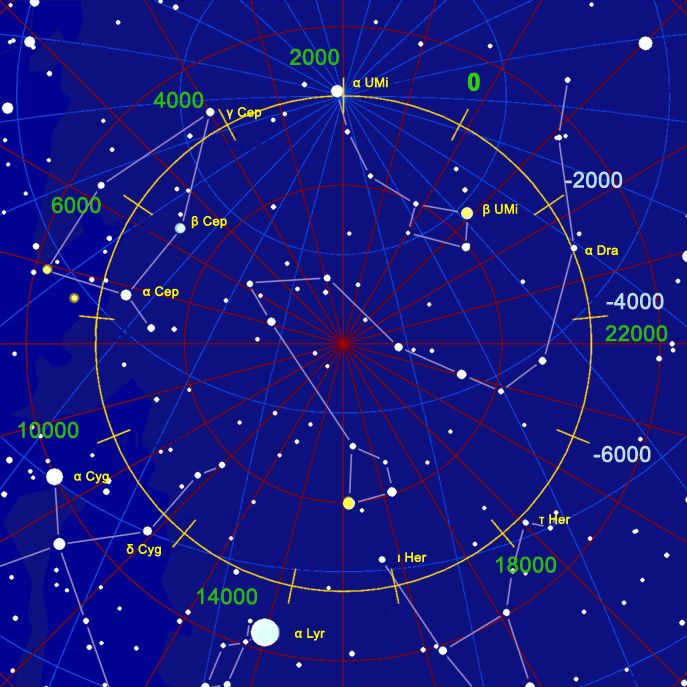
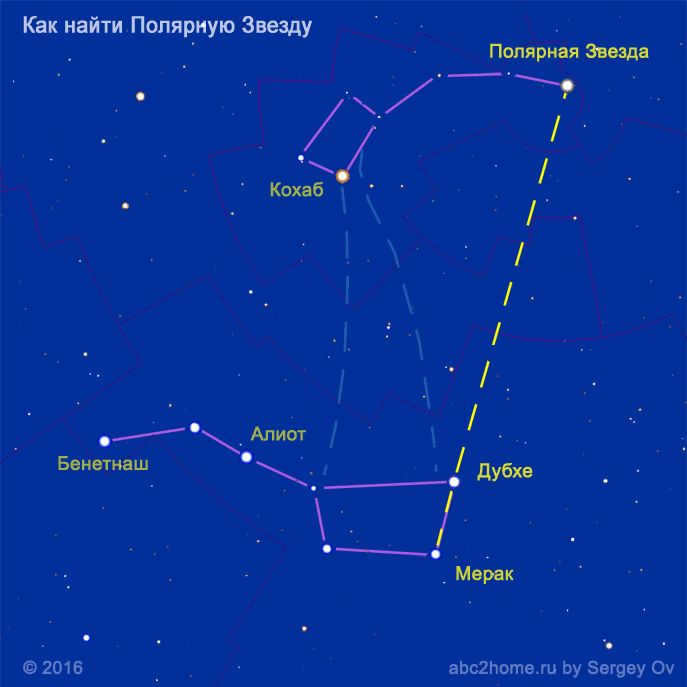
The constellation known as Ursa Minor, or the Little Bear, is home to a number of stars, including the famous Polaris. However, there are also several other, lesser-known stars that make up this constellation. One of these stars, located about 390 light-years away from Earth, is home to the 11th planet of the Ursa Minor system. This planet is an orange giant, which means it is in one of the later stages of its lifecycle. It has a radius that is 24 times that of our Sun, and a mass that is only 1.8 times greater. In 2009, astronomers made the exciting discovery of a planet orbiting this star, completing one revolution around it every 516 days. This planet is estimated to have a mass that is 10.5 times that of Jupiter.
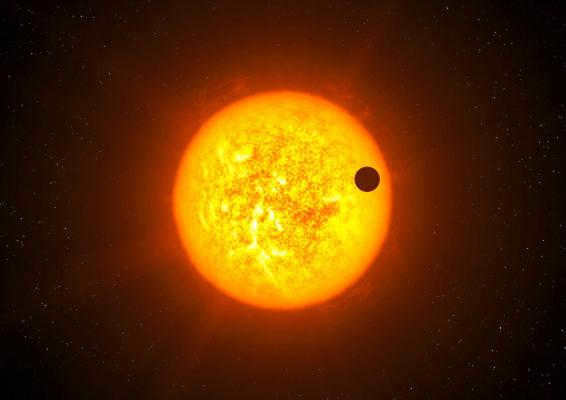

In the field of astronomy, there is a star known as HD 150706 which has its own planet. This star is located at a distance of 100 light-years away from our planet Earth. Scientists have estimated that the planet completes one orbit around its star in approximately six thousand days.
Asterisms
Asterisms are clusters of stars that form recognizable shapes or patterns in the night sky. These formations are not official constellations, but they are still widely recognized and used as celestial landmarks.
One well-known asterism is the Big Dipper, which is part of the larger constellation Ursa Major. The Big Dipper is made up of seven bright stars that form the shape of a ladle or dipper.
Another popular asterism is the Summer Triangle, which is formed by three bright stars: Vega, Deneb, and Altair. These stars are part of the constellations Lyra, Cygnus, and Aquila, respectively.
Asterisms are often used by stargazers and astronomers to locate other stars and constellations in the sky. They serve as convenient reference points and can help navigate the vastness of the night sky.
While not officially recognized as constellations, asterisms have their own unique charm and significance in the world of astronomy. They continue to capture the imagination of people who gaze up at the stars and wonder about the mysteries of the universe.
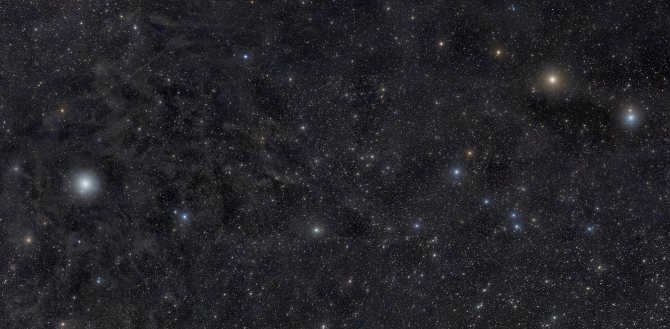
Photo of the Small Bucket asterism taken by astrophotographer Rogelio Bernal Andreo
Within the constellation, there are two notable asterisms: the Small Bucket and the Guardians of the Pole. The Small Bucket is familiar to contemporary observers. The Little Bear constellation’s Small Bucket is very similar to its neighboring Big Bucket, but not as bright. It is comprised of the most prominent stars in the celestial formation. Some mistakenly believe that the Little Bear is comprised solely of these seven objects, however, there are actually 18 additional stars within its composition.
The second asterism is much less well-known, and its name has ancient origins. During that time, the two stars that form it, Ferkad and Cohab, were positioned closer to the pole than Polaris.
Diminutive yet powerful
Although seemingly unremarkable, the Little Bear constellation holds a significant place in both scientific and artistic literature. Spanning a relatively small area of only 256 square degrees, it ranks fifty-sixth among the eighty-eight constellations. However, its age and inclusion in ancient celestial maps, such as Ptolemy’s “Almagest,” cannot solely account for its enduring popularity.
So what sets the Little Bear apart? The answer lies in its primary luminary, Polaris. For centuries, humans have singled out this modest star, despite its faintness compared to luminous giants like Sirius or Vega. It is Polaris that has secured the Little Bear’s fame.
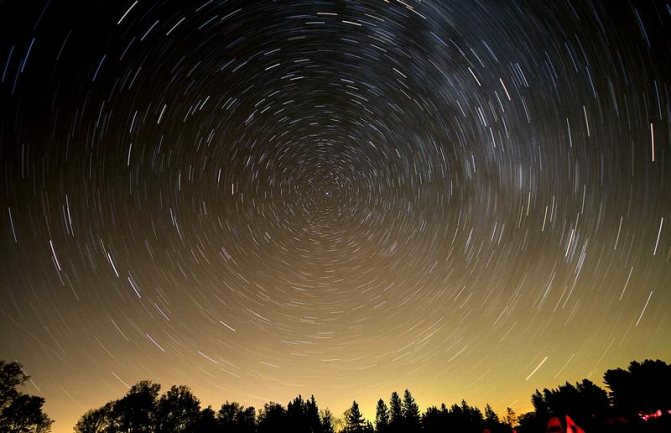
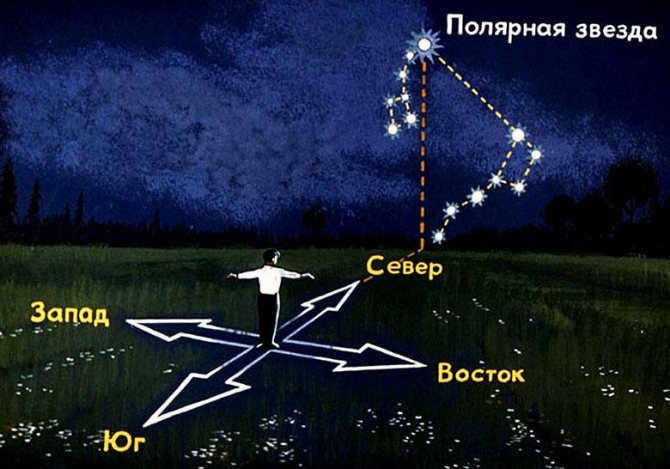
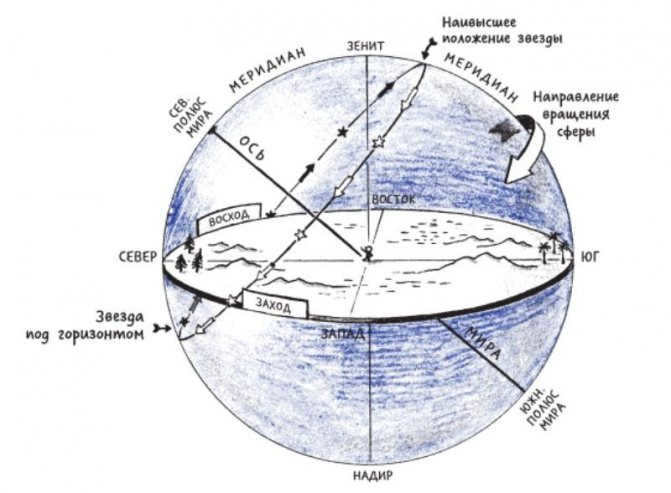
Location of the constellation Ursa Minor
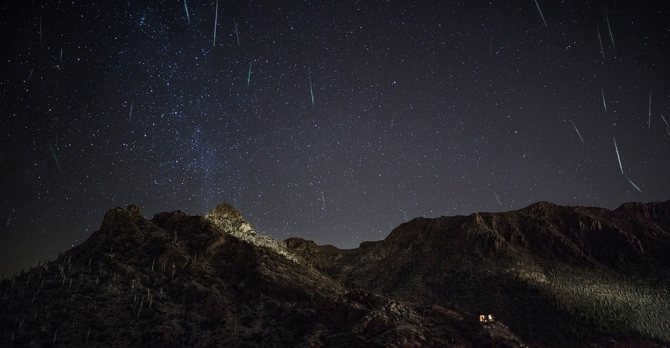
The Little Dipper functions as the radiant point for the Ursid meteor shower, which is the final celestial event of the year and is relatively underexplored. The radiant point is located near the constellation of the Little Dipper, and the meteor shower takes place between December 17 and 25 with highly unpredictable activity. Typically, during the peak days, observers may witness around 10 to 20 meteors per hour, which may not be particularly captivating for the average viewer. However, there are sporadic surges in activity, when the number of meteors surpasses one hundred. Remarkable meteor showers occurred in 1988, 1994, 2000, 2006, and notably in 1945 and 1986. This meteor stream is the most northern of its kind and can be attributed to the short-period comet Tuttle.
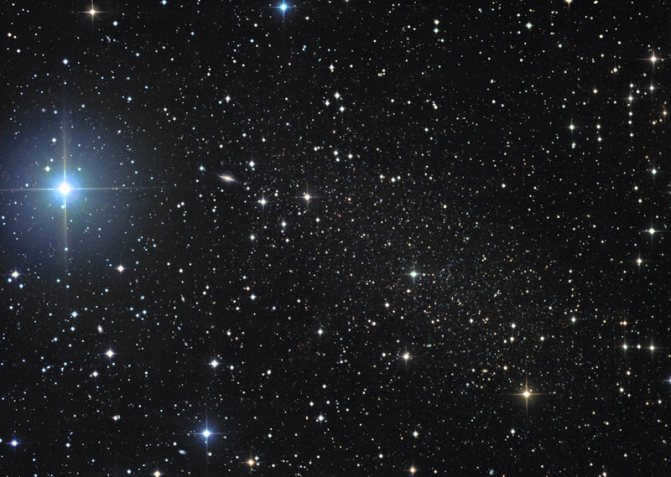
Photograph of the dwarf galaxy in Ursa Minor
Aside from the primary stars, there is also interest in the galaxies situated within Ursa Minor. The aforementioned dwarf galaxy, which is a companion to the Milky Way, was first observed in 1954. It is a relatively ancient galaxy, with an estimated age of at least ten billion years. Due to its size, it is difficult to determine if it contains any gas, dust, or ongoing star formation processes. It is sometimes referred to as Polarissima due to its proximity to Earth’s rotational axis.
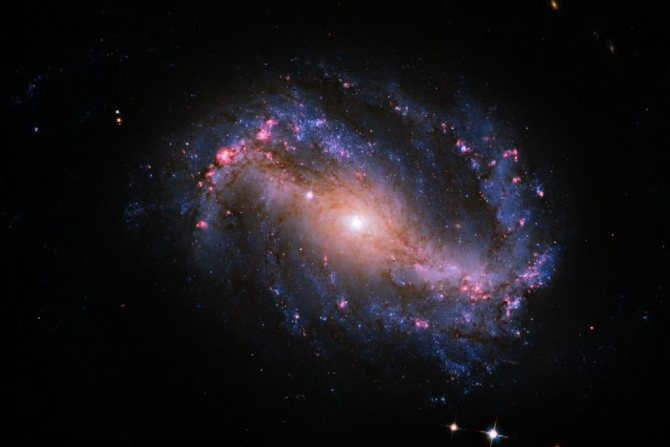
Moreover, NGC 6217 and NGC 5832 can be found within the constellation. All these celestial entities are quite diminutive in size, making it necessary to rely on advanced optical instruments in order to observe them.
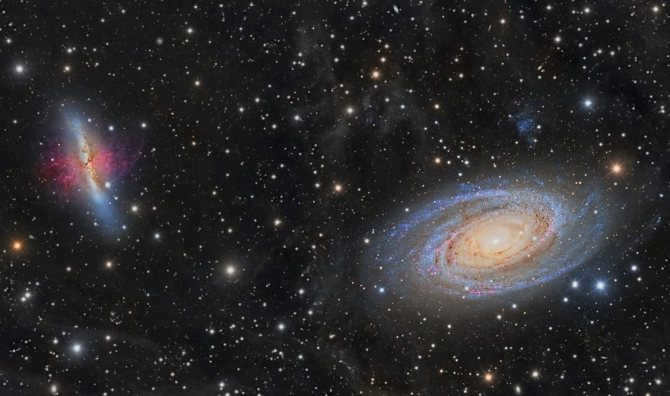
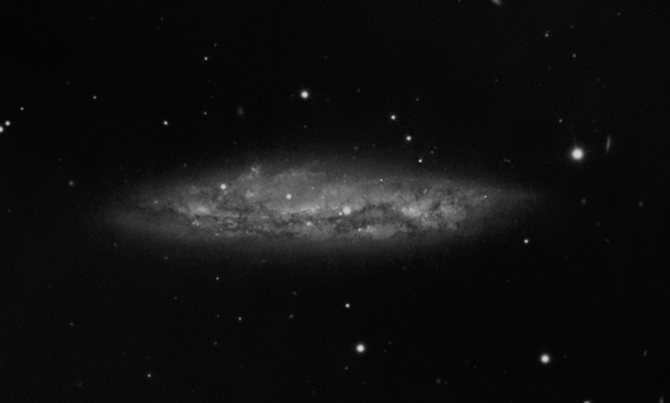
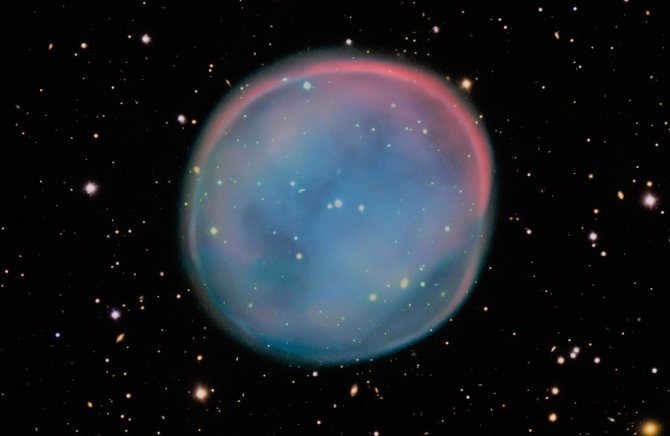
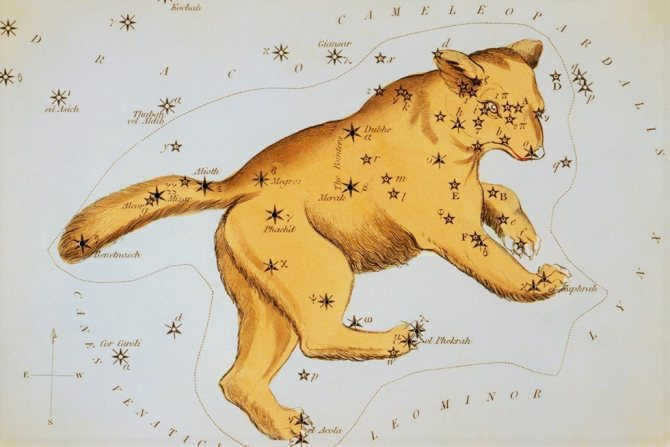
Reasons behind Polaris’ Fame
When one gazes upon the celestial sphere at night, Polaris may not immediately stand out. There is a common misconception that it shines brighter than other stars or emits a different hue. However, these beliefs about the star are inaccurate.
Polaris is renowned for other reasons. Firstly, this celestial body is in close proximity to the Earth’s geographic pole. By observing it, one can always determine the location of the North. This has enabled people to navigate accurately for centuries, ensuring they do not lose their way even when traversing the open seas.
Secondly, all celestial objects complete a full revolution within 24 hours, while the Guiding Star remains fixed in its position. The reason for this is that it is located precisely on the line that connects the north and south poles, serving as the central point around which other luminous objects in the sky rotate.
Thirdly, Polaris not only serves as a guide for determining direction and orientation, but it also allows for the calculation of latitude. To do this, one needs to measure its altitude, which is the angle between the star’s direction and the horizon. The resulting measurement will indicate the latitude of your location.
The celestial point at the pole of the world has held significant importance for astronomy since ancient times, and has also been highly regarded by explorers and adventurers around the globe. However, it is only visible to those living in the Northern regions. In the southern hemisphere, there is no prominent landmark in close proximity to the imaginary line of the pole.
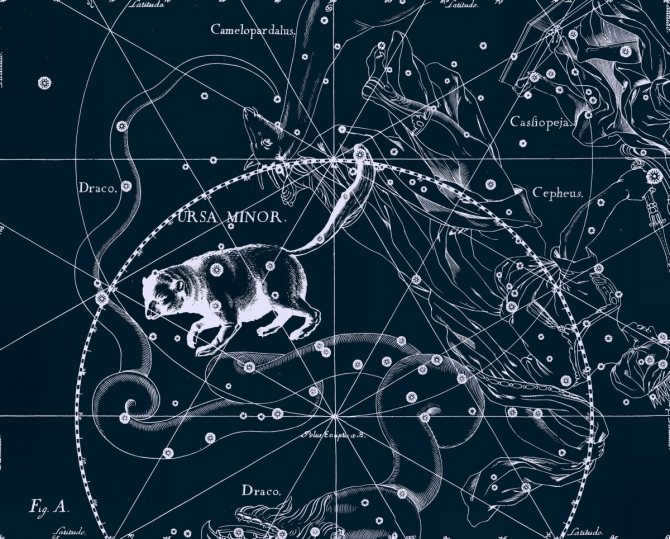
The image of the Little Dipper was created by Jan Hevelius in his collection of constellation drawings.
The origin of the Little Bear constellation dates back to ancient times. It is believed that Thales of Miletus, an ancient astronomer, included it in the Ptolemaic catalog. In Greek mythology, celestial events were often associated with mythological stories. According to one version, the Little Bear constellation represents Callisto, a nymph who was transformed into a bear along with her mistress. To protect them, Zeus placed them in the heavens, granting them eternal life. The stars in this constellation were well-known to many ancient civilizations and were used for navigation purposes.
Even individuals who have no knowledge of astronomy can easily locate the Big Dipper in the sky. Because it is close to the North Pole, the Big Dipper is visible in the sky throughout the year from dusk to dawn. However, the position of the Big Dipper in relation to the horizon changes during the day and throughout the year. For instance, during the summer, the ladle of the Big Dipper descends slowly from west to northwest, with the handle pointing upward. In dark August nights, the seven bright stars of the dipper can be seen low in the north. In the fall, the dipper rises above the northeastern horizon closer to dawn, and the handle seems to point to the point of sunrise. In early December evenings, the Big Dipper is seen low in the north, but during long winter nights, it rises high above the horizon by morning and can be found almost overhead. At the end of the winter, the dipper of the Big Dipper is visible in the northeast with the handle down, and by morning it shifts to the northwest with the handle up. Given its recognition and favorable visibility on clear evenings, the Big Dipper is often used as a starting point for finding other constellations, including the Little Dipper which contains the famous star Polaris. Despite its fame, Polaris is rarely seen by those unfamiliar with the stars. It is similar in brightness to the stars of the Big Dipper, but the other stars of the Little Dipper, except for one in the southern part of the constellation, are much fainter and may not be visible in brightly lit city skies. Therefore, for star gazing, it is best to choose an observation site outside of large cities or in a forest park. Let’s begin our journey into the starry sky by exploring four constellations of the northern sky: the Big Dipper, the Little Dipper (with Polaris), the Dragon, and Cassiopeia. These constellations can be found in the starry sky on any day and at any time due to their proximity to the North Pole. Start by locating the Big Dipper, which is well-known to everyone. If you have trouble finding it, remember that it is in the northwest during summer evenings, in the north during autumn, in the northeast during winter, and directly overhead in spring. Next, notice the two outermost stars of the Big Dipper. If you mentally draw a straight line through these stars, the first star that is comparable in brightness to the stars of the Big Dipper is Polaris, which belongs to the Little Dipper constellation. Use the map provided to try to find the other stars of the Little Dipper. If you are observing from an urban area, it may be difficult to see the stars of the Little Dipper as they are not as bright as those of the Big Dipper. Binoculars may be helpful in this case. Once you have located the Little Dipper, you can try to find Cassiopeia. This constellation may remind you of a coffee pot. Look for the second star from the end of the handle of the Big Dipper. Next to this star, you will see a barely visible star with the naked eye. The bright star is called Mizar, and the one next to it is Alcor. It is said that Mizar is a horse and Alcor is a rider when translated from Arabic. Now draw a mental straight line from Mizar through Polaris and continue the same distance. You will see a bright constellation in the shape of a W, which is Cassiopeia. Doesn’t it look a bit like a coffee pot? After Cassiopeia, let’s try to find the Dragon constellation. As shown in the picture, it extends between the buckets of the Big and Little Dipper, and further towards Cepheus, Lyra, Hercules, and the Swan. We will discuss these constellations later, but once you have some experience navigating the starry sky, try to use the drawing to find the complete Dragon constellation. Now you should be able to locate the Big and Little Dipper, Cassiopeia, and the Dragon in the sky. By observing these constellations regularly, you will quickly become familiar with them and be able to distinguish them from the rest of the starry sky. Finding other constellations will become easier! For those who wish to continue studying the treasures of the starry sky, we recommend keeping an observing log. In this log, you can record the date and time of your observations and sketch the position of the constellations relative to the horizon. Try to accurately reproduce the location of the bright stars and even the faintest stars in your sketches. As you become more familiar with the starry sky and use a telescope or binoculars to observe other objects, these sketching skills will be useful. It is also enjoyable to flip through an old observing journal and reminisce about past observations. Now, let’s answer some questions about the constellations we have explored: 1. During your observations, where was the constellation Cassiopeia located in the sky? 2. Where was the dipper of the Big Dipper located in the sky? 3. Were you able to see Alcor with the naked eye? 4. Keep a journal of your observations, noting the position of the constellations above the horizon in the evening, at night, and in the morning. This will allow you to observe the daily rotation of the celestial sphere. Don’t limit yourself to familiar constellations – also draw parts of the starry sky that are not yet familiar to you. One of the most famous constellations is the Little Bear, which is small in size and lacks bright stars. It is located near the North Pole and has played an important role in astronomy, navigation, and other fields for many centuries.
The birth of the constellation
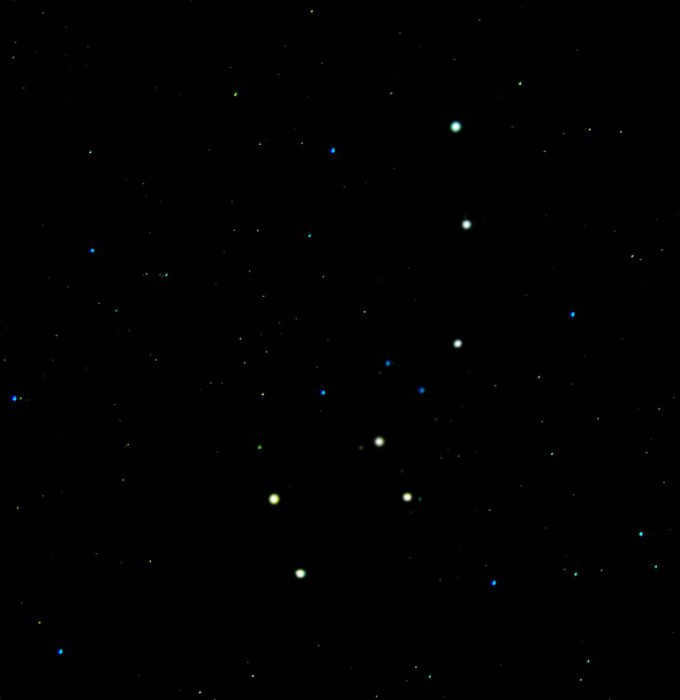
The cluster of stars known as the Little Dipper has a long and mysterious history. Its exact origin is difficult to determine due to its ancient age. References to the Big Dipper can be found in ancient writings, such as those by Homer. However, information about the Little Dipper was not recorded until much later, around the seventh century BC. According to the writings of Strabo, it is believed that the Little Bear constellation was not known in the time of Homer and was only discovered and used for navigation by the Phoenicians. It is suggested that earlier civilizations were not aware of the Little Bear’s existence and its location. It was only later included as a separate constellation due to its close proximity to the north pole. The Little Dipper is now widely recognized and used for navigation in astronomy, with its introduction dating back to approximately the sixth century BC by F. Miletus.
Myths and legends: Unraveling the Stories of the Past
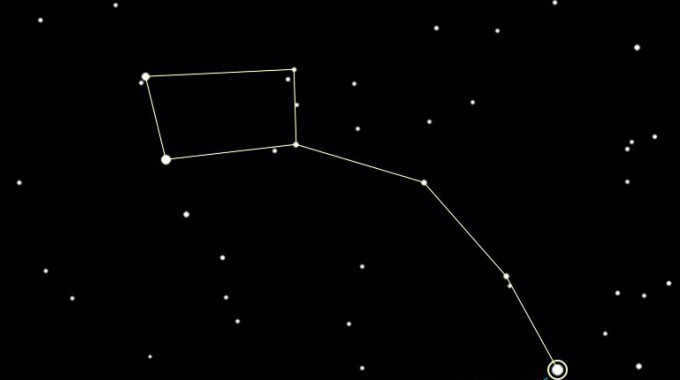
Where the constellation is located
So, how can we locate the Little Bear? Before attempting to find the constellation in the night sky, it’s important to know what it looks like. The main feature of the constellation is the dipper, although it is not as prominent as the bucket of the Big Dipper. To locate all the stars in the Little Bear, you must first locate the Big Dipper. Simply draw an imaginary line through the outermost stars of the dipper, curving slightly. Then, extend this line upwards by five similar segments. This line will lead you to Polaris, a bright star that marks the end of the handle of the Little Bear’s scoop. Now, what’s the next step? Where do we find the Little Dipper and where should we go from Polaris? From Polaris, you should move towards the Big Dipper, where the bucket itself is located. Unlike the Big Dipper, the handle of the Little Dipper bends in the opposite direction. Now it’s clear where the Little Bear is situated in relation to the Big Dipper.
The crucial aspect is to avoid mixing up
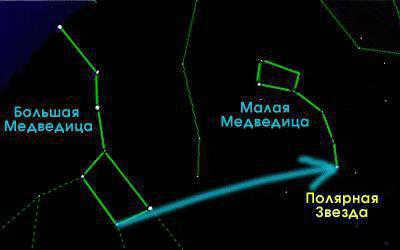
In this particular grouping of stars, similar to the well-known Big Dipper, there are a total of seven stars, although they do not possess the same level of brightness. Out of these stars, three of them shine the brightest, while the remaining four may not always be visible during the nighttime. Due to this unique characteristic, many novice stargazers who observe through a telescope often confuse this grouping with the well-known Little Dipper. However, once you become familiar with the location of the Little Dipper and manage to spot it at least once, it is highly unlikely that you will ever lose sight of it again.
The most brilliant stars of the Big Dipper
There exist additional stars that compose the Big Dipper and its handle.
Polaris can indicate the location of the constellation Ursa Minor, also known as the Little Bear. This star is the brightest, comparable in brightness to the objects of the Big Dipper. Interestingly, Polaris only ranks 48th in the list of the brightest stars and is not the brightest, contrary to popular belief. Polaris can be likened to a fixed nail in the night sky, around which all the other stars revolve.
The next star is known as Kochab or Beta. It has a similar brilliance to Polaris and emits an orange glow. This star is cooler than our sun and forty times larger in size.
Ferkab is another massive star. It is hotter than both Kochab and Polaris, but its brightness is several times lower.
All the stars in the constellation
The Little Bear constellation contains several notable stars, including Ferkab, Cohab, and Polaris. These stars are known for their brightness and are always visible in the night sky. While the constellation contains a total of forty-seven objects, only seven can be seen without the aid of a telescope, and even then, only in optimal weather conditions. Typically, only three stars from the constellation are visible to the naked eye.
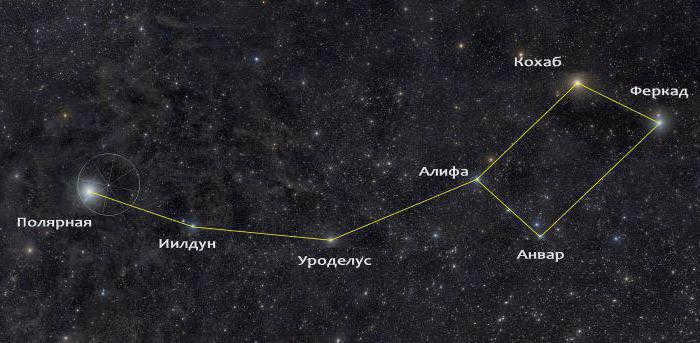
A group of seven stars form the shape of a ladle with a handle, allowing observers to easily locate the Little Bear constellation in the night sky. The remaining forty stars are often overlooked by casual stargazers. However, if all these stars are connected with lines, they form a schematic representation of a bear, although some argue that it more closely resembles a dog. Interestingly, the ancient Greeks referred to the North Star as Kinosura, meaning “the dog’s tail.” Perhaps they, too, connected the stars to create constellations and saw a charming dog in the celestial drawing. The answer to this question remains a mystery to astronomers and scientists worldwide.
Learning how to find the Little Dipper, Cassiopeia, and the Dragon
So, we have located Mizar. Now, envision a straight line from Mizar through the North Star and continue for the same distance. You will likely spot a fairly bright constellation in the shape of the letter W (see image). That would be Cassiopeia. It does bear some resemblance to a coffee pot, doesn’t it?
After locating Cassiopeia, let’s attempt to find the constellation Draco. As depicted in the image at the top of the page, it extends between the “handles” of the Big and Little Dipper, extending further towards Cepheus, Lyra, Hercules, and Cygnus. We will delve into these constellations later, but once you have some basic experience orienting yourself in the night sky, give the drawing above a try to locate Draco in its entirety.
Now you will have no difficulty finding the constellations of the Great and Small Bears, Cassiopeia, and the Draco in the celestial sphere.
Queries:
1. In which part of the celestial sphere was the constellation Cassiopeia situated during your observations?
2. In which part of the celestial sphere was the “ladle” of the Big Dipper located?
3. Were you able to perceive Alcor without any optical aid?
(Latin. Ursa Minor) is a circumpolar constellation in the Northern Hemisphere. It occupies a space of 255.9 square degrees in the celestial sphere and encompasses 40 stars discernible to the naked eye.
In the Small Bear is currently the North Pole of the world, at a separation of about 1° from Polaris. The constellation was presumably singled out by the Phoenicians as being advantageous for navigation.
click on the image to expand it
Stellar Objects
The most luminous celestial objects in the star grouping:
- Polaris (α UMi). Magnitude of the star’s brightness is 2.02m.
- Cohab (β UMi). Apparent magnitude of the star’s brightness is 2.08m. From approximately 2000 B.C. to 500 A.D., Cohab served as the most brilliant star in close proximity to the Earth’s North Pole and assumed the role of a polar star, as evidenced by its Arabic name Kohab al-Shemali (Star of the North).
- Ferkad (γ UMi). Magnitude of the star’s brightness is 3.05m.
Asterisms
Asterism Small Pail creates a distinctive and memorable pattern in the celestial sphere. It consists of seven stars – α (Polaris), β (Cohab), γ (Ferkad), δ, ε, ζ, and η of the Little Dipper. The Small Pail bears a resemblance to the shape of the Big Pail asterism, which is located nearby in the constellation Big Dipper.
The two outermost stars of the Pail (Cohab and Ferkad) symbolize the asterism Guardians of the Pole.
Exploring the heavens
You can see the constellation at any time of the year. To locate Polaris, also known as the alpha star of Ursa Minor, you need to mentally extend the line between Merak, the beta star of the Big Dipper, and Dubhe, the alpha star of the Big Dipper, to a length five times greater than the original.
Origin
According to Hyginus, Thales of Miletus introduced this constellation to ancient astronomy, and it is listed in the Almagest catalog of the night sky.
The Phoenicians, the skilled navigators of ancient times, utilized the constellation for their navigation, in contrast to the Greeks who relied on the Big Dipper, which is clearly less precise.
In Kazakhstan, the people referred to Polaris as the “iron nail” (Temir-Kazyk), symbolically driven into the sky, and they associated the other stars of the Little Dipper with a harness attached to this nail, worn around the neck of the Horse (the constellation of the Big Dipper). The Arabs, on the other hand, perceived the stars of the Little Dipper as horsemen, while the Persians identified it as the Seven Fruits of the Date Palm.
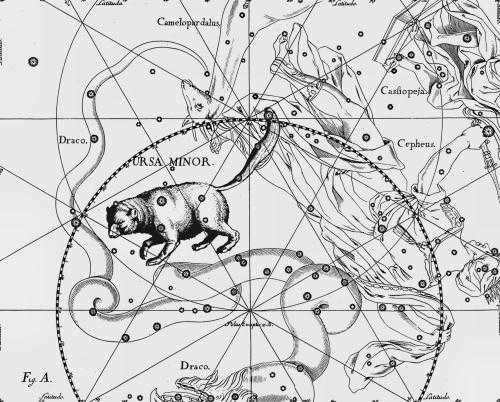

The position of the Little Dipper can be seen in this image from the Uranographia Atlas by Jan Hevelius (1690).
Click on the image to view it in a larger size.
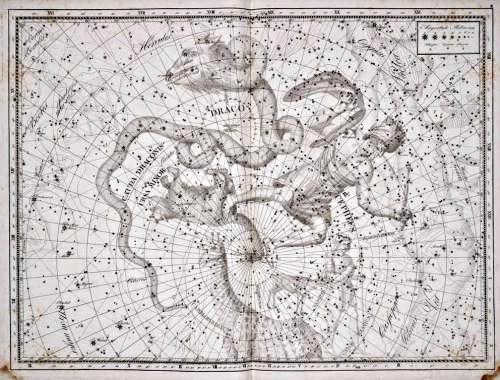
The article provides a concise overview of the Little Bear constellation, which can be found in the northern hemisphere.
A narrative on the Little Bear constellation
The Little Bear constellation shares a close connection with the Big Dipper, not only through myths and legends, but also in terms of their proximity in the night sky: it extends from the stars of the Big Dipper’s handle, Merak and Dubhe.
The Tale of the Little Bear Constellation
The tale of the constellation revolves around Callisto, the daughter of the king of Arcadia. Known for her exceptional beauty, Callisto caught the attention of the mighty Zeus. In order to approach her, Zeus disguised himself as Artemis, the goddess whom Callisto served. Their encounter resulted in the birth of a son named Arcades. However, when Hera, the jealous wife of Zeus, discovered this, she transformed the lovely servant girl into a bear.
How is the appearance of the Little Bear described?
The ancient Greeks portrayed the Little Bear in the sky with a unique and elongated tail, unlike the actual bear. This celestial constellation is also known as Kinosura, which translates to “dog’s tail”.
What is the star count in the Little Bear?
Compared to other constellations, the Little Bear is relatively small in size. It can be observed in the northern hemisphere and, under optimal conditions, approximately 25 stars can be seen with the naked eye. Among these stars, the three brightest ones are α, β, and γ.
Polaris (α) is the most luminous star in the Little Bear. It is located very close to the celestial pole and remains almost motionless, while the other stars appear to revolve around it. Polaris is a massive star, much hotter than the Sun, and it has two companions.
Kohab (β) is nearly as bright as Polaris, and it has an orange color and a spectral structure. Despite being 40 times larger than the Sun, Kohab is cooler than the Sun and much brighter than our own star.
The star Ferkad (γ) is also classified as a giant star. It is hotter than Kohab and Polaris, but it is much farther away, so it appears less bright compared to them.
The three brightest stars in the Little Bear constellation form the asterism known as the Guardians of the Pole.
We hope that learning about the Big Dipper has expanded your knowledge of astronomy. Feel free to share your thoughts on the Big Dipper in the comment section below.
There are certain constellations in the night sky that are widely recognized, and the Little Bear constellation is one of them.
The Little Bear constellation is situated in the circumpolar area of the celestial sphere and comprises 25 stars. However, only seven of them are commonly recognized by the majority, creating a group of stars known as the Little Bucket. The most renowned star of the constellation is , which is nearly aligned with the Earth’s North Pole. Besides the relatively bright stars, the constellation also accommodates a diminutive elliptical galaxy, referred to as the Little Dwarf due to its size.
Place
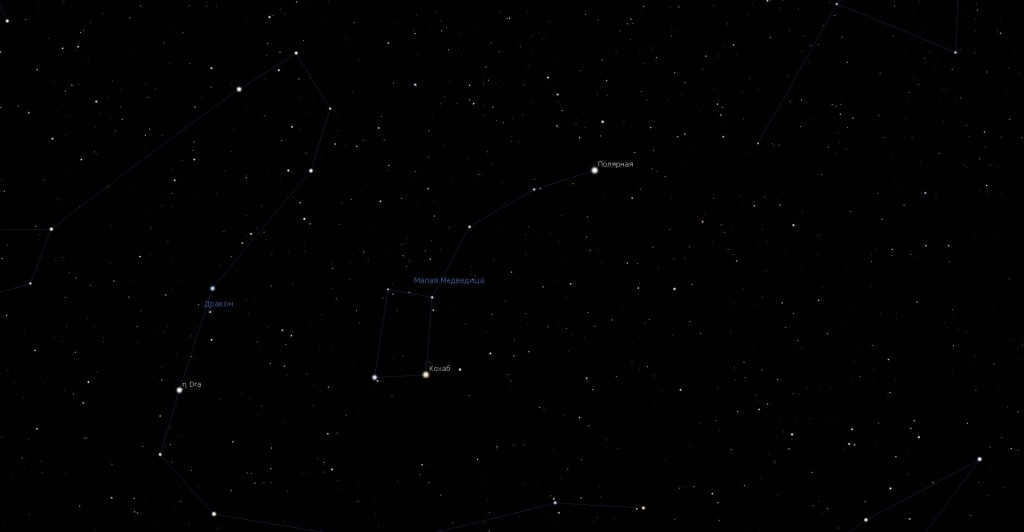
Constellation of the Little Dwarf, observed through the Stellarium planetarium program
Locating this constellation in the celestial sphere is a relatively straightforward task. Its neighboring constellations include the Giraffe, Dragon, and Cepheus. However, the usual starting point for the search is . By drawing a line connecting the two outermost stars of its dipper shape and extending it upwards by five times the distance between them, one can locate Polaris, which serves as the starting point for the “handle” of another, smaller dipper. This smaller dipper is known as the Little Dipper. While it is not as bright as the Big Dipper, it is still clearly visible in the night sky and easily distinguishable from other constellations. In the Northern Hemisphere, this constellation can be observed all year round.
Arctic, the Center of the World
The Arctic region is the central point on the celestial sphere that remains fixed to an observer on Earth, while all other celestial bodies orbit around it. If there is a prominent star nearby, it can serve as a fixed reference point, as its position remains constant regardless of the time of day. Due to the unique motion of the Earth, this point does shift, but over the course of centuries, it can be considered relatively unchanged. Currently, the closest star to the Arctic is Polaris, which is only 40 minutes of arc away from it.
Polaris
Polaris is a star in the constellation Ursa Minor, also known as the North Star. It is a highly visible star that has been used for navigation and orientation for centuries. Polaris is located at the end of the handle of the Little Dipper and is the brightest star in the constellation. Its position in the sky remains almost fixed, making it a reliable point of reference for celestial navigation. Polaris has also been used by astronomers to study the Earth’s rotation and the movement of the stars.
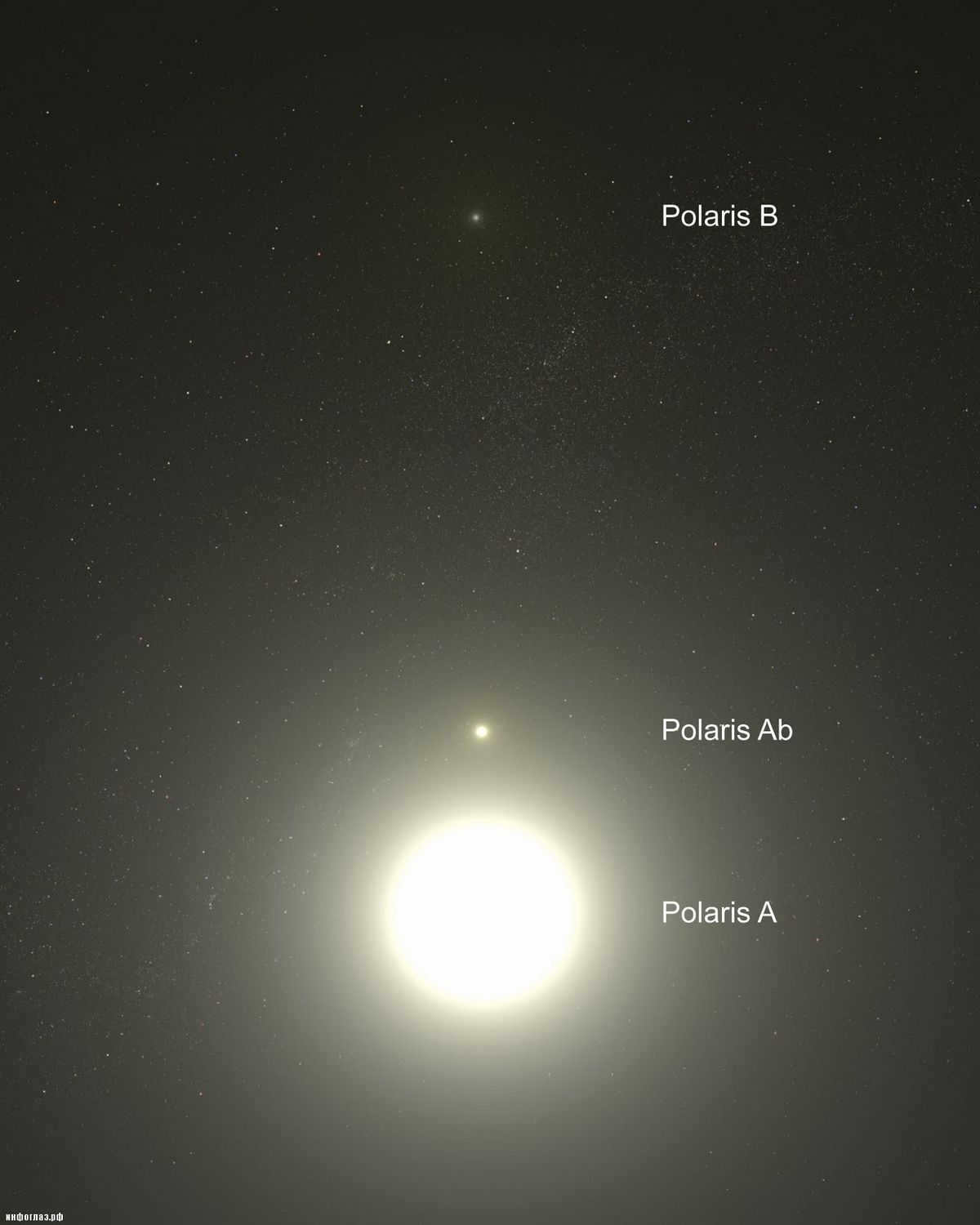
Alpha of the Little Bear is situated about 434 light-years away from our planet and displays an apparent magnitude of 1.97. However, it is not just a single star, but rather a system consisting of three stars. The largest of these stars is around 4.5 times more massive than our Sun and shines with a brightness that is two thousand times greater. The second largest star is located at a significant distance from the main star and can even be observed using a small telescope. This star has a mass of approximately 1.39 times that of our Sun. The third star is positioned so close to the first star that they can only be visually distinguished with the assistance of a telescope, and even then it is a challenging task. This star is 1.25 times more massive than our Sun.
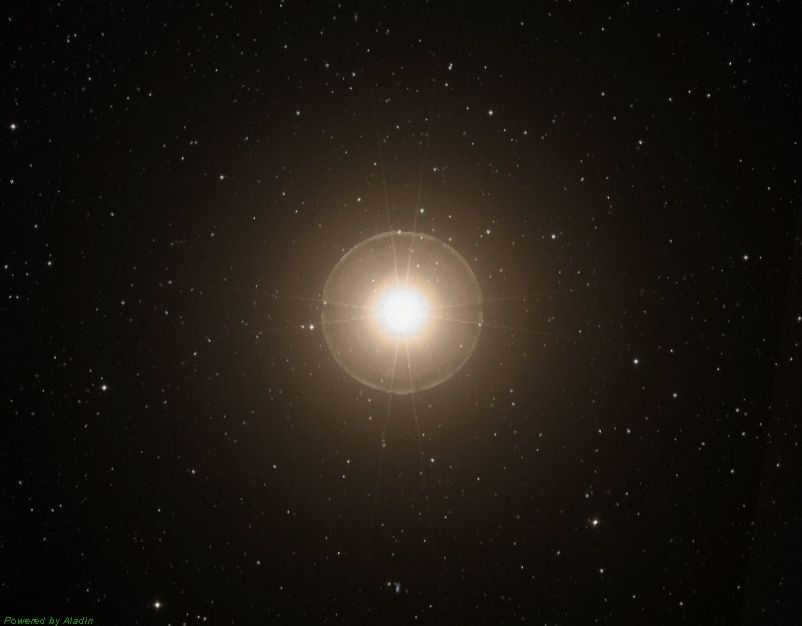
The beta star of the Little Bear, with an apparent magnitude of 2.08, is the second brightest star in the constellation. This star is located approximately 126 light-years away from Earth. Its name, which translates from Arabic as “Star of the North,” comes from its historical role as a navigational reference point for ancient peoples. From around 2000 to 500 years before our era, Kohab was the closest star to the pole. In 2014, Korean astronomers discovered a planet orbiting this double star. The planet has a mass 6.1 times that of Jupiter and completes one orbit every 522.3 days.
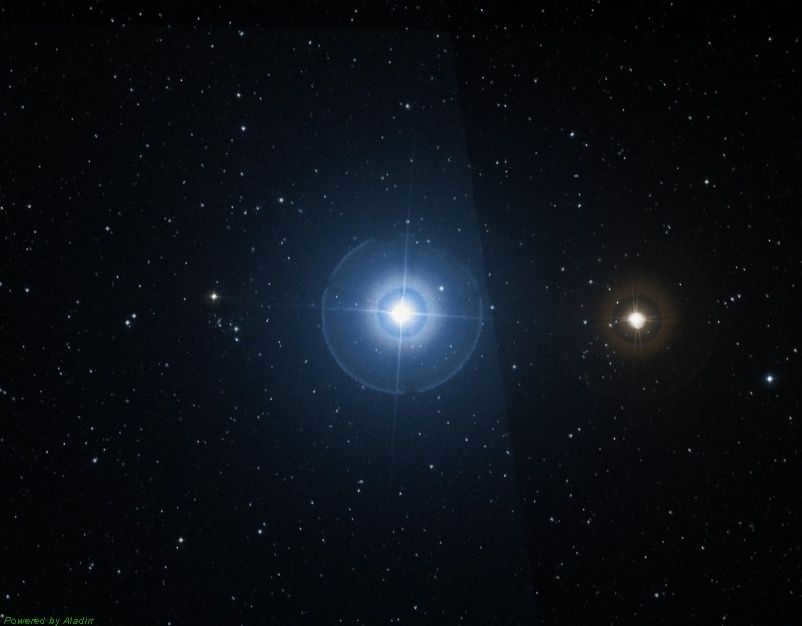
Located approximately 480 light-years away from Earth, Gamma Minor displays an apparent magnitude that ranges from 3.04 to 3.09. The luminary’s luminosity undergoes a 3.43-hour period of change. This particular star, ranking as the third brightest object within the constellation, is classified as a hot giant with a temperature of around 8600 K. Its luminosity exceeds that of the sun by 1.1 thousand times, and it also boasts a size 15 times larger than our yellow dwarf. It is categorized as a T Shield type variable luminary.
Groupings of Stars
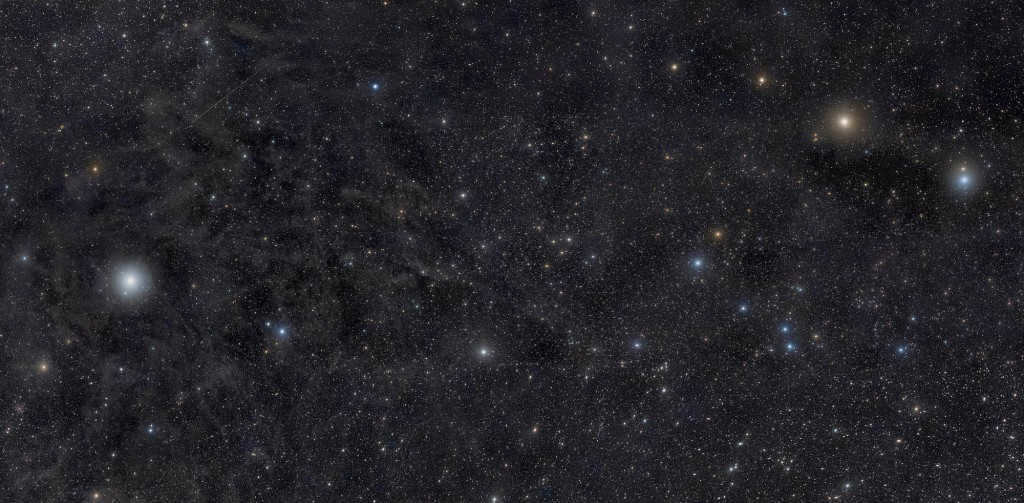
The constellation consists of two asterisms: the Small Dipper and the Guardians of the North. The former is familiar to modern observers and bears a strong resemblance to the Big Dipper, which is located nearby but is not as bright. It is formed by the most prominent stars in the celestial formation. Many people mistakenly believe that the Small Bear is composed only of these seven objects, but in reality, there are 18 additional stars included in its composition.
The second asterism is much less well-known and its name can be traced back to ancient times, when the two stars that form it, known as Ferkad and Kohab, were closer to the pole than Polaris.
Meteor streams
can be paraphrased as “Streams of meteors” or “Flow of meteors.”
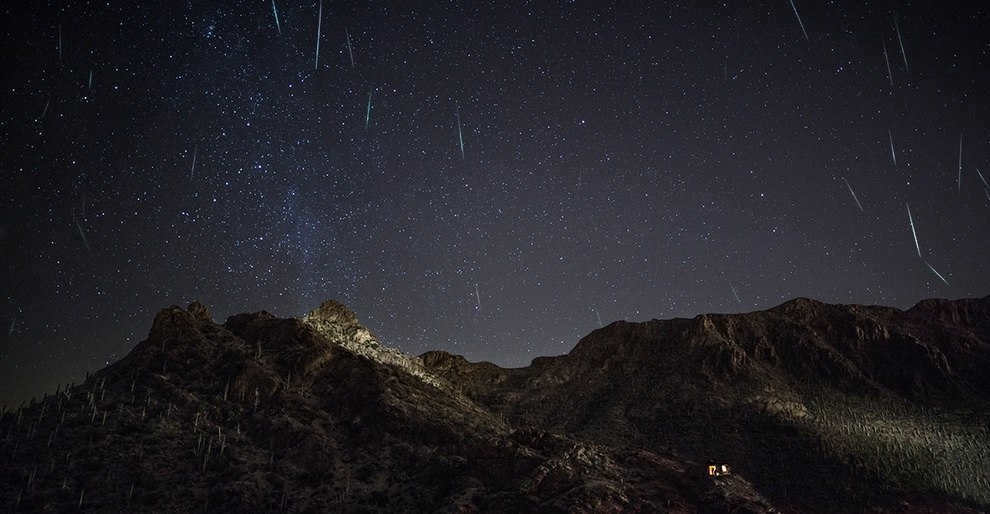
The constellation Ursa Minor, also known as the Little Dipper, is home to a meteor shower called the last “starburst” of the year. This meteor shower, which occurs between December 17 and 25, is not well-studied and is known for its extreme unpredictability. On the most active days, observers can expect to see 10 to 20 meteors per hour, which may not be very exciting for the average viewer. However, there have been instances of unpredictable bursts of activity, with over a hundred meteors visible in an hour. Some notable years for this meteor shower include 1988, 1994, 2000, 2006, and particularly 1945 and 1986. This meteor shower is the northernmost of its kind and is believed to originate from the short-period comet Tuttle.
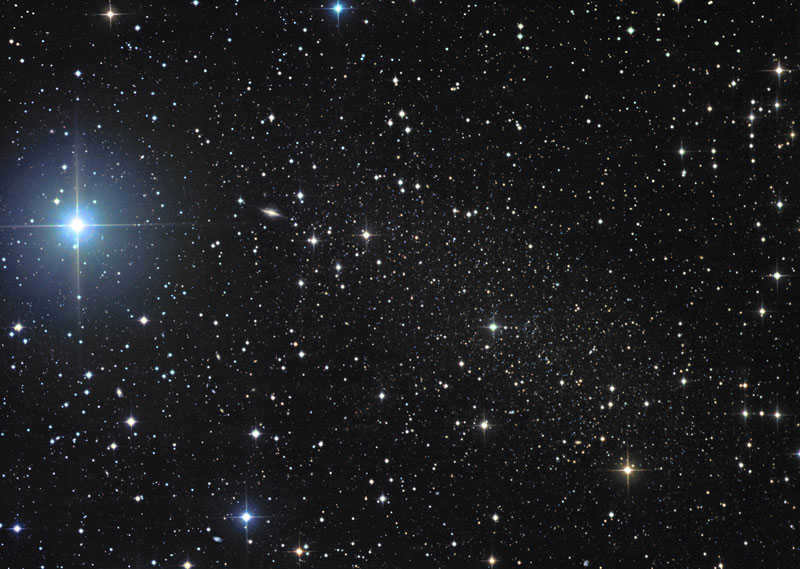
Aside from the primary celestial bodies within Ursa Minor, there is fascination surrounding the galaxies situated within it. One such galaxy, previously mentioned, is the Dwarf, which acts as a companion to the Milky Way and was first observed in 1954. This galaxy is relatively ancient, having existed for a minimum of ten billion years. Due to its size, it is impossible to determine if it contains any gas, dust, or ongoing stellar formation processes. Occasionally referred to as Polarissima, this name is derived from its close proximity to the Earth’s rotational axis.

Furthermore, the constellation encompasses NGC 6217 and NGC 5832 galaxies. All these entities are minuscule in the grand scheme of the universe, making it impracticable to perceive them without adept optical tools.
The constellation’s origins
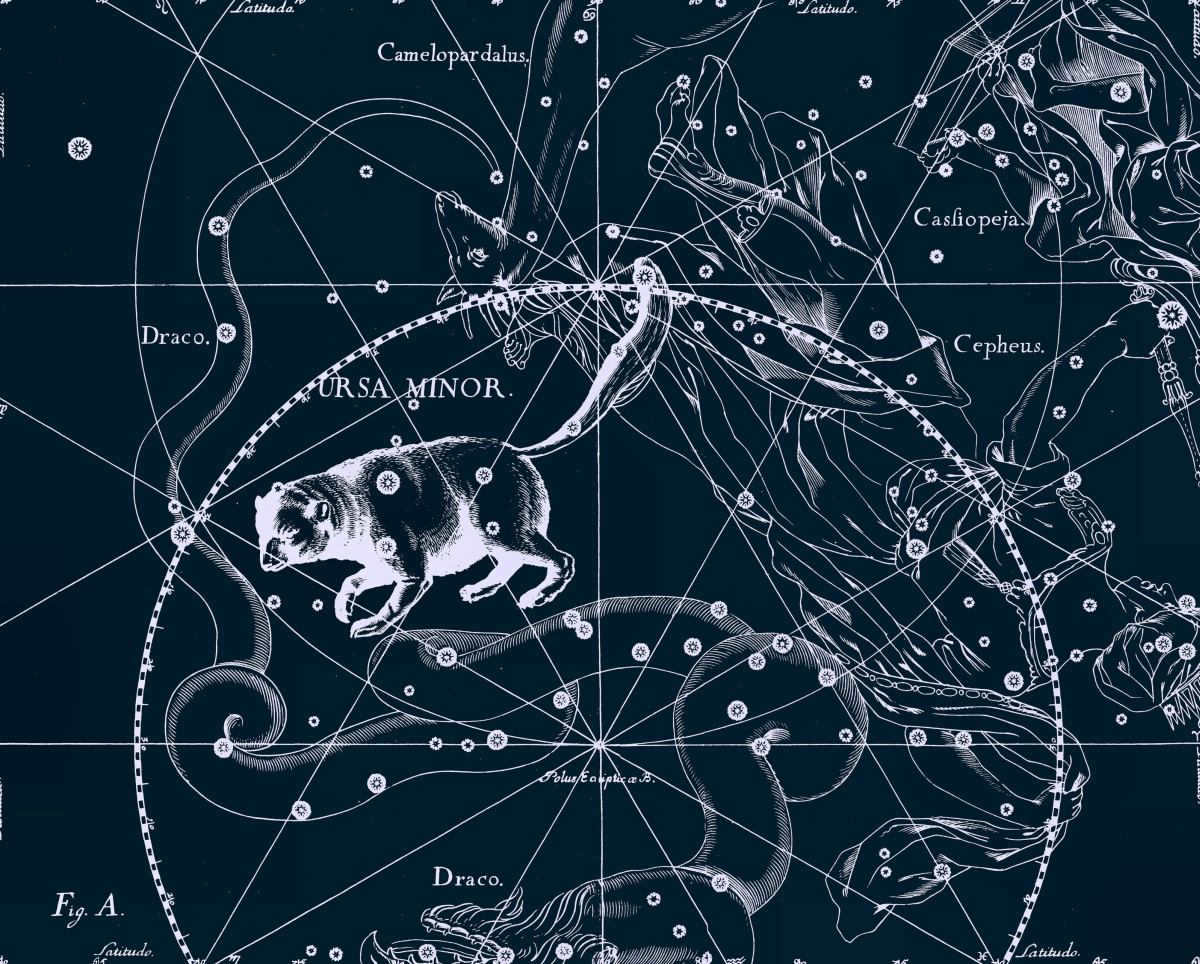
Mastering the art of locating the Ursa Minor, Cassiopeia, and Draco constellations
So, let’s begin our introduction to the celestial sky. Today we will acquaint ourselves with four constellations of the Northern sky: Ursa Major, Ursa Minor (including the famous Polaris), Draco, and Cassiopeia. These constellations, being close to the North Pole, never set in the European territory of the former USSR. This means that they can be seen in the night sky on any day and at any time. To start, let’s look for the well-known “Big Dipper” constellation. Have you located it in the sky? If not, remember that during summer evenings, the “ladle” can be found in the northwest, in the fall it is in the north, in winter it is in the northeast, and in spring it is directly overhead. Now, let’s focus on the two outermost stars of this “dipper” (see fig.).
So, Mizar has been discovered. Now, visualize a mental straight line extending from Mitsar through the North Star and continue for a similar distance. You will then see a rather bright constellation in the shape of the Latin letter W (refer to the image). That constellation is known as Cassiopeia. It does bear some resemblance to a coffee pot, doesn’t it?
After locating Cassiopeia, we can attempt to find the Dragon constellation. As shown in the image at the top of the page, it stretches between the “buckets” of the Big and Little Dipper, extending towards Cepheus, Lyra, Hercules, and the Swan. We will discuss these constellations in more detail later, and once we have gained some basic experience in navigating the night sky, we can fully locate the Dragon constellation using the mentioned diagram.
Now it should be effortless to locate the constellations of Ursa Major and Ursa Minor, Cassiopeia, and Draco in the celestial sphere.
Queries:
1. During your observations, where was the constellation Cassiopeia situated in the sky?
2. Where was the “ladle” of the Plough constellation positioned in the sky?
3. Were you able to spot Alcor with your unaided eyes?
Arguably the most renowned constellation in the celestial sphere of the northern hemisphere of Earth. The Big Dipper asterism, comprising of its seven brightest stars, can be seen throughout the year in the mid latitudes. This makes it an essential guide for locating other constellations in the sky and for navigation on Earth.
It is likely that many individuals are familiar with the constellation known as the Little Bear, which is located not far from the Big Dipper and can be seen in the night sky throughout the year. The Small Dipper asterism is formed by its bright stars, although not everyone is able to locate it, along with the actual constellation of the Little Bear. Nevertheless, this constellation holds significance for those living in the northern hemisphere of the Earth, as it is home to the famous Polaris, which serves as a guide to the north.
Here, we will briefly explain how to locate the Little Bear using the Big Dipper as a starting point. This task is relatively simple and straightforward.
The first step is to locate the constellation of the Big Dipper in the night sky. It is important to note that the constellation is much larger than the familiar dipper shape. You can easily spot the Big Dipper in the spring, as it reaches its highest point in the evenings. During the summer, the Big Dipper can be found in the western part of the sky, with the dipper tilted slightly downward.
The Big Dipper’s position in mid-summer is depicted in the image below. Image: Stellarium
In the autumn, the Big Dipper is positioned low on the horizon in the northern direction, appearing almost horizontal…
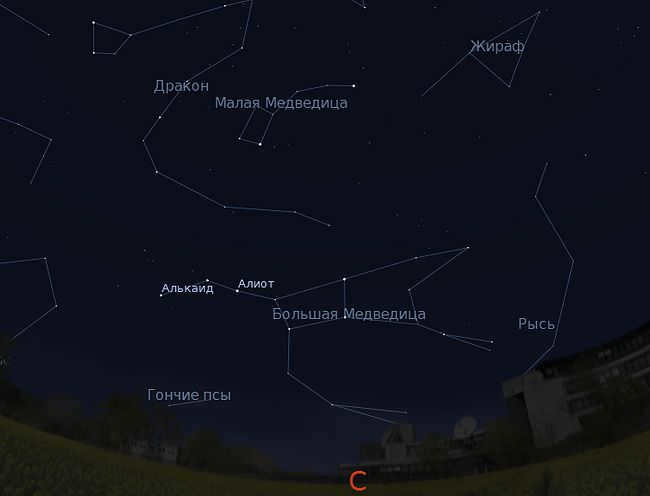
The Little Dipper can be found in the fall. Illustration: Stellarium
…and during the winter season, it appears in the eastern sky, with the Ladle constellation almost perpendicular to its handle.
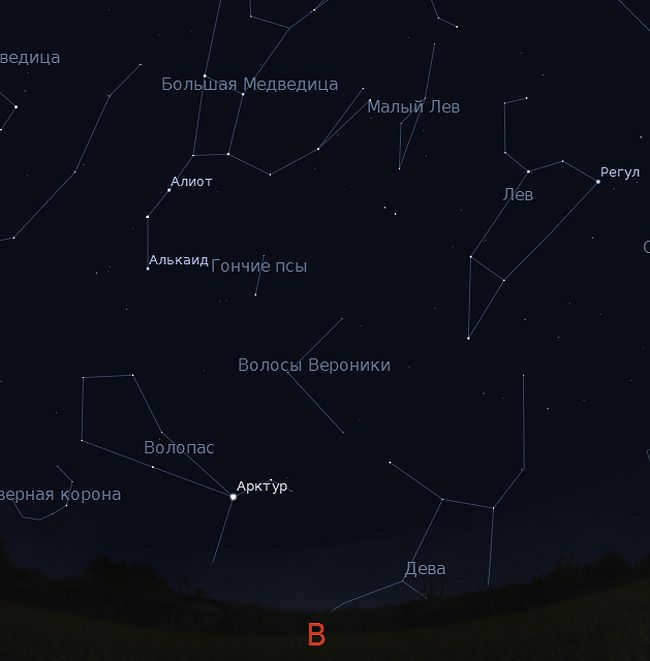
In the winter season, the Big Bucket can be located towards the eastern direction. Observation: Stellarium
Once you have successfully identified the Big Dipper, mentally visualize connecting the two outermost stars, namely Merak and Dubhe, which form the wall of the Dipper, using a straight line. Next, prolong the line by a distance that is five times the Merak-Dubhe distance. . This extended line will lead you towards a star that possesses the same level of brightness as the stars present in the bucket. This specific star happens to be the brightest one within the constellation of the Little Dipper.
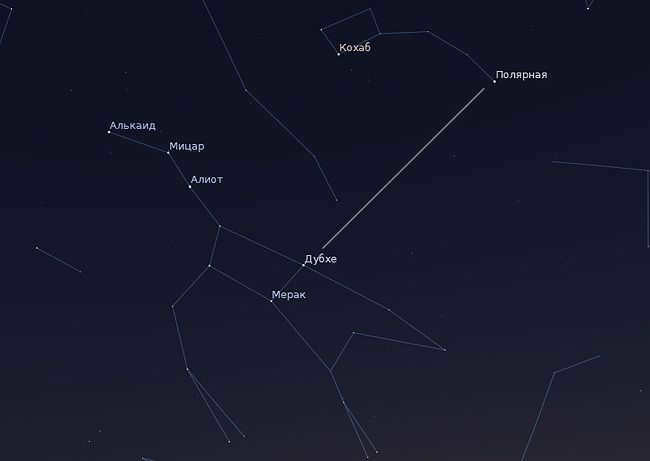
If you are looking to locate the constellation of the Little Dipper in the spring, you can do so by using the Big Dipper as a guide. The Merak-Dubhe line in the Big Dipper points directly to Polaris, which is also known as the North Star. In addition to Polaris, the other two brightest stars of the Little Dipper, known as Kochab and Pherkad, can be found above the handle of the Big Dipper. By using these stars as reference points, you can easily locate the Little Dipper in the night sky. It’s worth noting that the image provided is a representation of the night sky and was created using Stellarium software.
Polaris is situated at the tip of the handle of the Small Dipper. The stars that comprise the Small Dipper are generally much fainter compared to the stars of the Big Dipper, thus locating the Little Dipper in an urban environment or under a backlit sky can be challenging. The Small Dipper is approximately half the size of the Big Dipper, and its handle curves in the opposite direction. Among the seven stars that form this asterism, only three are consistently visible in urban areas: Polaris in the handle, and the stars Cohab and Ferkad, which form the wall of the Little Bucket. The remaining two stars are positioned above the handle of the Big Dipper.
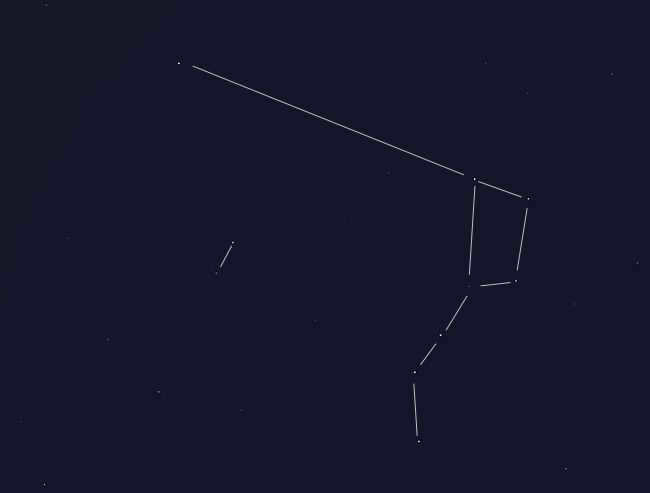
Within the urban environment, the only visible components of the entire constellation known as the Little Dipper are Polaris, as well as the stars forming the wall of the Small Bucket, namely Cohab and Ferkad. The latter two stars are situated above the handle of the Big Dipper and are visually represented by a dash in the provided image for enhanced clarity. This particular arrangement of the Big Dipper in relation to the Little Dipper can typically be observed during the spring season, when the Big Dipper is positioned almost directly overhead. Illustration: Stellarium
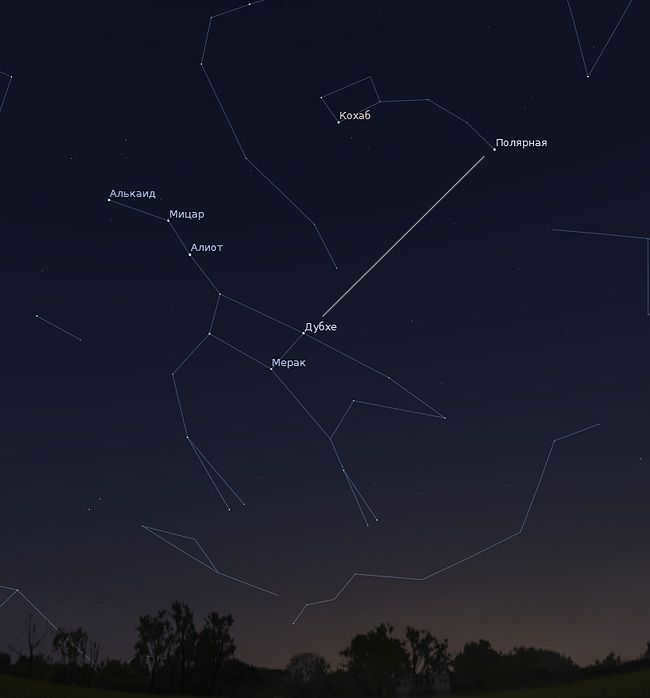
Even though the Big Dipper’s position changes throughout the seasons, Polaris remains fixed. The technique of locating Polaris using the outer stars of the Big Dipper can be used year-round. Figure: Stellarium
This is made possible by the proximity of Polaris to . Polaris’s unique characteristic of staying in one place allows it to serve as a reliable landmark on the ground. In fact, if you draw a perpendicular line from Polaris to the horizon, it will accurately point north. However, not only Polaris, but also the Big Dipper can help with orientation on land. During spring, the handle of the Big Dipper faces east, while the dipper itself faces west. In other seasons, as mentioned previously, in the evenings. The Big Dipper can be found in the west, north, or east, aiding in determining the cardinal directions.
The Small Dipper is a constellation in the Northern Hemisphere that consists of 25 stars that are visible to the naked eye. The seven largest stars in this constellation form a pattern that resembles a bucket in the sky. The handle of the bucket is completed by the star Polaris. Due to its position, the Small Dipper can be observed in the night sky using certain reference points, even without the aid of a telescope.
How to locate the Little Dipper – choose the optimal surroundings
To ensure a successful stargazing experience, keep these recommendations in mind:
- Opt for a cloudless night to easily spot the stars, without any obstructing clouds or layered formations in the sky;
- Venture outside of urban areas, where the presence of bright streetlights and illuminated windows can interfere with your view. Instead, seek out a vast expanse of dark sky, where locating the Little Dipper will be effortless;
- When commencing your observation, position yourself in a manner that allows for an unobstructed horizon, free from the obstruction of tall trees or buildings. Ideally, no obstacles should be present, ensuring a clear and unhindered view.
How to locate the Little Bear using Polaris
To locate the Little Bear, it is best to look for Polaris near the Big Dipper, which has the shape of a large ladle. This well-known star is not the brightest in the sky. You can observe the constellation during clear nights in the fall and winter, when it hangs in the northern part of the sky. In the spring, it stands upright in the east with the handle pointing downwards, and in the summer, it can be seen in the west with the handle pointing upwards.
- To find the Big Dipper, follow our recommendations. Connect all the stars mentally with a line to form a bucket with a handle.
- Take note of the bowl made up of 4 stars. The outermost stars, Dubhe and Merak, can be used as reference points to locate Polaris.
- If you are still unable to fully visualize the Little Dipper after going through this explanation, here is a helpful tip:
Try using the following clue.
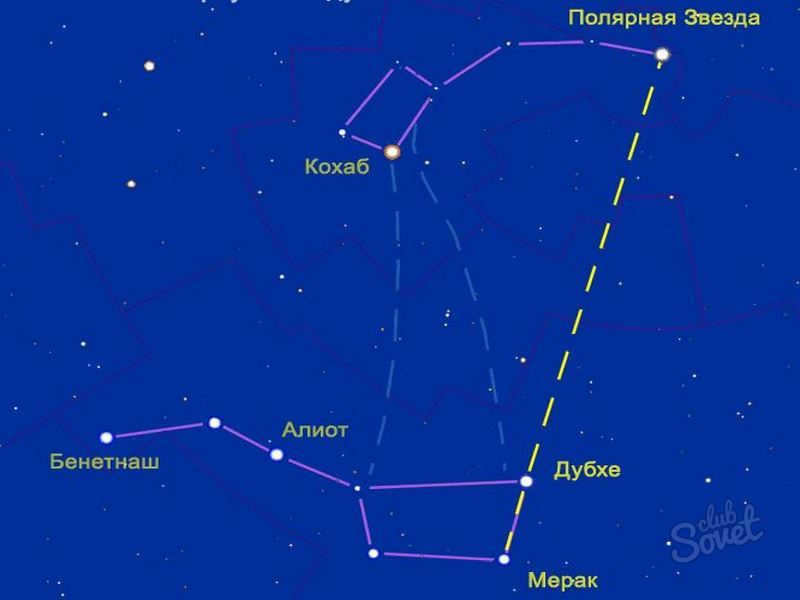
Guide to Locating the Little Dipper
Have you managed to locate Polaris, but are struggling to find the Little Dipper? In such a case, you can use the prominent stars on the front rim of the Little Dipper’s bowl – Kochab and Pherkad – as additional reference points.
- Direct your gaze towards the left side of Polaris and you will notice a light-colored circle surrounded by an orange halo – this is Kochab. Just above it, forming the upper corner of the bowl, you will find Pherkad. These stars orbit around Polaris and are known as the Guardians of the Pole.
- Take a closer look and you will spot two more stars that make up the inner corners of the bowl. Connect them with lines and you will have a dipper shape without a handle.
- Locate the two faintly shimmering star points amidst the constellation between the bowl and the Polaris. Join the remaining spaces with straight line sections and you will unveil a diminutive ladle with a grip pointing in the opposite direction to that of the handle of the prominent Big Dipper.
While the Little Dipper can be observed at any given moment, it is most effectively observed during the winter season prior to daybreak or within the initial hour of the setting sun in spring.
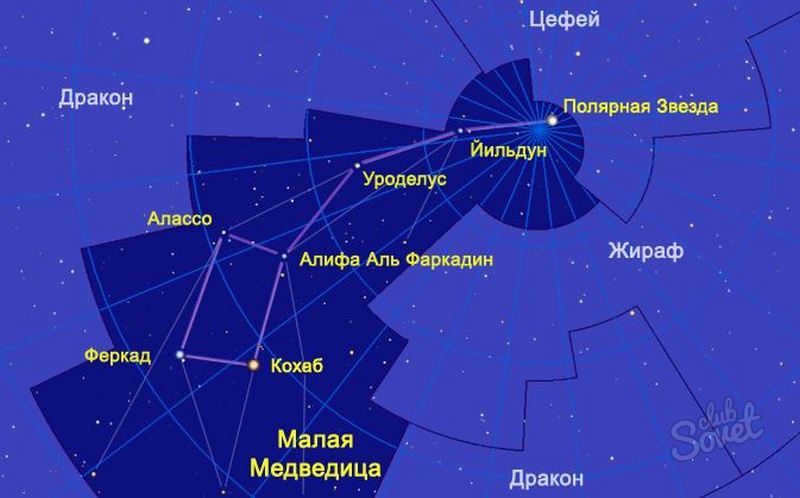
If you have the opportunity, take some time to escape to nature and unwind from the hustle and bustle of the city. Take a moment to marvel at the dazzling array of stars in the night sky and ponder the mysteries of far-off, undiscovered worlds whose light has yet to reach our planet.
Little Bear refers to several different things. For other meanings, see Little Bear (disambiguation).
| Constellation | |
Polaris, the most brilliant star in the constellation, is a supergiant of yellow-white color and the most luminous variable Cepheid star in the nighttime sky. It has an apparent magnitude that ranges from 1.97 to 2.00. Kochab, also known as Beta of the Little Bear, is an aging star that has expanded and cooled, transforming into an orange giant with an apparent magnitude of 2.08, which is only slightly dimmer than Polaris. Kochab and Gamma, a star of magnitude 3 in the Little Bear, have been referred to as the “protectors” of Polaris. [3] Four stars, including Kochab, have been found to have planets orbiting them. Additionally, the constellation contains a solitary neutron star named Calvera, as well as H1504+65, the hottest white dwarf ever discovered, with a surface temperature of 200,000 K.
The story of history and mythology
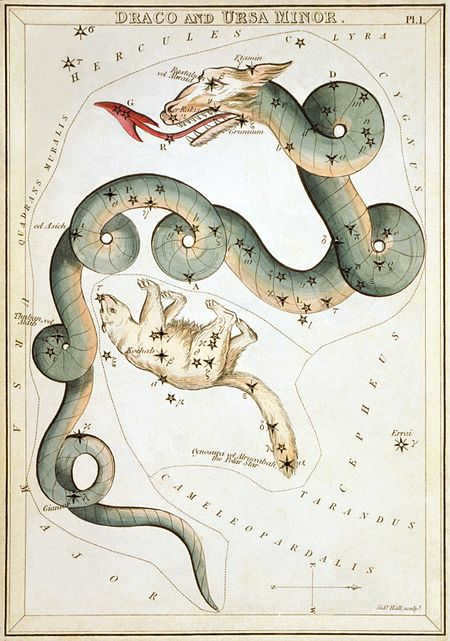
The constellation of Ursa Minor, which Draco revolves around, can be seen in the Mirror of Urania, a collection of constellation maps published in London around 1825.
In the ancient Babylonian Star Catalogs, Ursa Minor was referred to as the “Wagon of Heaven” (MUL MAR.GÍD.DA.AN.NA), and it was also associated with the goddess Damkin. It is listed in the MUL.APIN catalog, compiled around 1000 BC, as part of the “Stars of Enlil.” This constellation represents the northern sky.
According to Diogenes Laertius, Callimachus stated that Thales of Miletus “measured the stars of the Wagon on which the Phoenicians sailed.” Diogenes identified these stars as the constellation of the Little Bear, which the Phoenicians supposedly used for navigation at sea. Phoinikē. [6] [7] The tradition of referring to the northern constellations as “bears” appears to be genuinely Greek, although Homer only mentions a single “bear”. [8] Therefore, the original “bear” is the Big Dipper, and the Little Dipper was later recognized as the second, or “Phoenician bear” (Ursa Phoenicia, hence Φοινίκη, Phoenice), according to Strabo (I.1.6, C3) at the suggestion of Thales, who offered it as a navigational aid to the Greeks, who were familiar with the Big Dipper. In classical antiquity, the celestial pole was slightly closer to the Beta of the Little Bear than the Alpha of the Little Bear, and the entire constellation was considered to indicate a northerly direction. From medieval times, it became convenient to use Alpha Ursae Minoris (or “Polaris”) as Polaris, even though it was still a few degrees away from the pole of the world. [9] [a] His New Latin Name. Stella Polaris Stella Polaris was not coined until the early Modern period. The ancient name of the constellation Cynosura (Greek Κυνοσούρα “dog’s tail”). The origin of this name is unclear (the Little Dipper being a “dog’s tail” implies that another nearby constellation is a “dog”, but no such constellation is known). [10] Instead, the mythographic tradition of. Catasterism makes Cynosure the name of an Oread nymph described as Zeus’ nurse, honored by the god with a place in the sky. [11] There are various interpretations of the name Cynosura. One suggestion links it to the myth of Callisto, with her son Arkas replaced by her dog, placed in the sky by Zeus. [10] Others have suggested that an ancient interpretation of the Big Dipper was a cow forming a group with the Magus as a shepherd and the Little Dipper as a dog. [12] George William Cox explained this as a variation of Λυκόσουρα, understood as “wolf’s tail” but etymologized by him as “a trail or plume of light” (i.e. λύκος “wolf” vs. λύκ- “light”). Allen points to the Old Irish name for the constellation, chatterer “fire trail,” for comparison. Brown (1899) suggested a non-Greek origin of the name (borrowing from Assyrian An – nas-sur – ra “altitude”). [13]
Because the Little Dipper is made up of seven stars, the Latin term for “north” (i.e. where Polaris points) is derived from “septentrio” which means “seven” and “triones” which means “oxen”, referring to the seven oxen driving the plow and the resemblance to seven stars. This name was given to the main stars of the Big Dipper. [15]
In the Inuit culture, the three brightest stars, Polaris, Kochab, and Fercad, were referred to as “Nuutuittut” which means “never moving”, although this term is commonly used in the singular form to only refer to Polaris. Polaris is too high in the sky at extremely northern latitudes to be used for navigation. [16]
Distinctive Features
The Little Dipper is surrounded by Camelopardalis to the west, Draco to the west, and Cepheus to the east. Encompassing an area of 256 square degrees, it is the 56th largest constellation out of the 88. The Little Dipper is commonly referred to as the Little Bear in the United States because its seven brightest stars resemble a dipper (or ladle). The star at the end of the dipper’s handle is called Polaris. Polaris can also be located by drawing a line through the two stars, Alpha and Beta, of the Big Dipper, which mark the end of the Big Dipper’s “bowl,” at an angle of 30 degrees (equivalent to three vertical fists at arm’s length) across the night sky. [17] The four stars that form the bowl of the Little Bear range in magnitude from second to fifth, making it easy to determine the visibility of stars of different magnitudes, which is helpful for those living in urban areas or for testing eyesight. [18]
The IAU adopted the three-letter designation “UMi” for the constellation in 1922. [19] The official boundaries of the constellation were established by Belgian astronomer Eugène Delporte in 1930 and are defined by a polygon consisting of 22 segments (shown in the information window). In the equatorial coordinate system, the right ascension coordinates of these boundaries range from 08 h 41.4 m to 22 h 54.0 m, while the declination coordinates range from the north pole down to 65.40°. [1] Due to its location in the far northern celestial hemisphere, the entire constellation can only be seen by observers in the northern hemisphere. [20] [b]
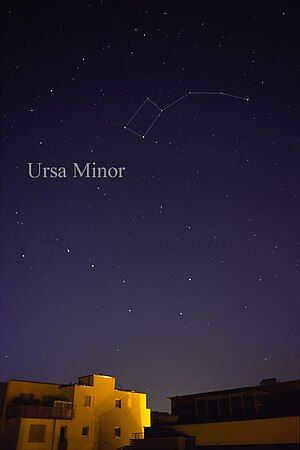
Stars
In the constellation, the German cartographer Johann Bayer employed Greek letters from alpha to theta to identify the most notable stars, with iota to phi later being added by his compatriot Johann Ehlert Bode. Lambda and pi were likely excluded due to their proximity to the Earth’s North Pole. [15] There are 39 stars within the boundaries of the constellation that have a brightness of apparent magnitude 6.5 or higher. [20] [c]
Alpha Minor, also known as Polaris or the Brightest Star in the constellation, is located at the tail of the Little Bear. Its apparent magnitude varies between 1.97 and 2.00 for a period of 3.97 days. It is situated approximately 432 light years away from our planet. This yellow-white supergiant star exhibits spectral classes F7Ib and F8Ib, with a mass that is about 6 times that of the Sun. Polaris shines with a brightness 2500 times greater than the Sun and has a radius that is 45 times larger. It is the most prominent Cepheid variable star that can be seen from Earth. Polaris is part of a triple star system, with two companion stars that orbit at distances of 17 and 2400 astronomical units (A.U.) from Earth. It takes these companion stars 29.6 and 42,000 years respectively to complete a full orbit around the main supergiant star.
Kochab, also known as Beta of the Little Bear, has an apparent magnitude of 2.08, which is only slightly dimmer than Polaris. [25] It is an orange giant, a star that has evolved from the main sequence by depleting its hydrogen core, and is classified as a K4III star. [25] Kochab is located approximately 131 light-years away from Earth. [26][d] By observing its oscillations, scientists have estimated Kochab’s mass to be 1.3 times that of the Sun. [27] Kochab is 450 times brighter than the Sun and has a diameter that is 42 times larger. It has a surface temperature of around 4130 K. [28] The age of Kochab is estimated to be around 2.95 billion years, with a margin of error of 1 billion years. It is accompanied by a planetary companion that is approximately 6.1 times more massive than Jupiter and has an orbital period of 522 days. [29]
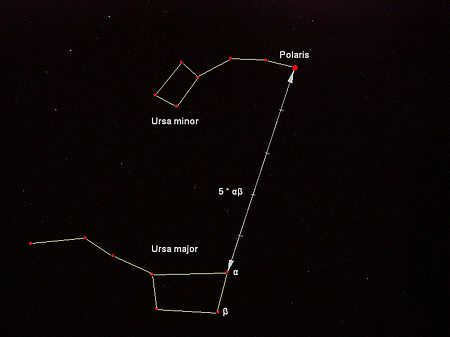
The handle of the Little Bear consists of two stars, Delta Little Bear and Epsilon Little Bear. Delta Little Bear is a white main-sequence star of spectral class A1V, located just over 3.5 degrees from the world’s north pole. It has an apparent magnitude of 4.35 and is located 172 ± 1 light-years from Earth. This star is also known as Yildun and is about 2.8 times the diameter of the Sun and 47 times brighter. Epsilon Ursae Minoris is a triple star system that shines with a combined light average magnitude of 4.22. The primary star, RS Canum Venaticorum, is a yellow giant of spectral class G5III and is a variable star. It is part of a spectral double system with a companion star at a distance of 0.36 astronomical units. The third star in this system is an orange main-sequence star of spectral class K0 and is located at a distance of 100 astronomical units.
Next to Polaris is Lambda Minor, which is a red giant of spectral class M1III. It is a semiregular variable star with a magnitude range of 6.35 to 6.45. [44] The constellation’s northern position allows for year-round observation of variable stars. One example is the red giant R Minor Bear, which is a semi-regular variable with a magnitude range of 8.5 to 11.5 over a period of 328 days. Another example is S Ursae Minoris, a long-period variable star with a magnitude range of 8.0 to 11 over a period of 331 days. [45] This constellation is located south of Cochab and Ferkad, towards Draco. RR Little Bear,[3] a red giant of spectral class M5III, is also a semiregular variable star with a magnitude range of 4.44 to 4.85 over a period of 43.3 days. [46] T Minor Bear is another variable red giant star that has undergone a significant change in status. It was originally a long-period (Mira) variable with a magnitude range of 7.8 to 15 over a period of 310 to 315 days, but now it is a semi-regular variable. [47] This change in variability was thought to be caused by a helium envelope flare, which occurs when the helium envelope around a star’s core reaches critical mass and ignites. The flare was marked by an abrupt change in the star’s variability in 1979. [48] Z Little Bear is a faint variable star that experienced a sudden decrease in magnitude of 6 stellar magnitudes in 1992. It belongs to a rare class of stars known as R Coronae Borealis variables. [49]
RW Minor Bear, a binary star system, experienced a cataclysmic event in 1956, transforming into a new star and shining with a magnitude of 6. By 2003, it remained significantly brighter than its starting point, with a decrease in brightness of approximately 0.02 magnitudes per year. Astronomers have determined that RW Minor Bear is situated in the galactic halo, at a distance of 5,000 ± 800 parsecs (equivalent to about 16,300 light-years). [54]
Derived from the antagonist in The Magnificent Seven, Calvera is the alias assigned to the X-ray source recognized as 1RXS J141256.0 + 792204 in the ROSAT Catalog of Bright Sources of All Sky Survey (RASS / BSC). [55] It has been identified as an isolated pulsar, one of the closest to our planet. [56] Ursa Minor contains two enigmatic white dwarfs. H1504 + 65 is a faint (magnitude 15.9) star with the highest surface temperature of 200,000 K ever observed for a white dwarf. Its atmosphere, composed of roughly equal parts carbon and oxygen, along with 2% neon, lacks hydrogen and helium – its composition remains unexplained by current models of stellar evolution. [57] WD 1337 + 705 is a cooler white dwarf with traces of magnesium and silicon in its spectrum, implying the presence of a companion or circumstellar disk, although no supporting evidence has yet been discovered. [58] WISE 1506 + 7027 is a T6 spectral class brown dwarf, situated a mere 11.1 +2.3
-1.3 light-years away from Earth. [59] A faint object with a magnitude of 14, it was detected by the Wide-field Infrared Survey Explorer (WISE) in 2011. [60]
In addition to Kochab, there have been discoveries of planets in three other star systems. 11 Little Bear is an orange giant star of spectral class K4III, which is approximately 1.8 times more massive than the Sun. It has undergone a cooling down and expansion phase for around 1.5 billion years, transitioning from an A-type main-sequence star. This star is located about 390 light-years away from us and has an apparent magnitude of 5.04. In 2009, astronomers detected a planet that is roughly 11 times the mass of Jupiter orbiting 11 Little Bear with a period of 516 days. [61] Another star with a planet is HD 120084, an evolved star that is classified as a yellow giant of spectral class G7III. This star has a mass approximately 2.4 times that of the Sun. In 2013, researchers accurately measured the star’s radial velocity and discovered a planet with a mass 4.5 times that of Jupiter. This planet has one of the most eccentric orbits ever observed, with an eccentricity of 0.66. [62] HD 150706 is a sun-like star of spectral class G0V, located at a distance of 89 light-years from our Solar System. Initially, it was believed to have a Jupiter-sized planet orbiting at a distance of 0.6 astronomical units (a.u.), but subsequent studies in 2007 showed that this was not the case. [63] Further research published in 2012 revealed the presence of a companion to HD 150706, which is approximately 2.7 times more massive than Jupiter. This companion takes about 16 years to complete a full orbit and is located at a distance of 6.8 a.u. from its star. [64]
Objects in the depths of space
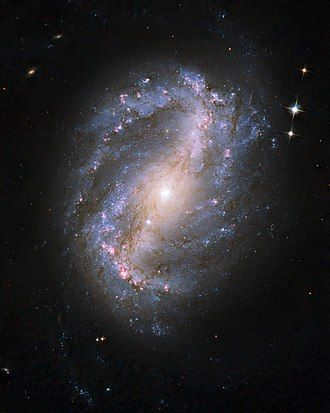
There are no celestial bodies in the Little Bear constellation. A dwarf spheroidal galaxy called the Little Dwarf was first observed by Albert George Wilson of Lowell Observatory during the Palomar Sky Survey in 1955. [65] It is located approximately 225,000 light-years away from Earth. [66] In 1999, the Hubble Space Telescope was used by Kenneth Mighell and Christopher Burke to confirm that the Little Dwarf experienced a single burst of star formation that lasted for about 2 billion years, occurring approximately 14 billion years ago. [67] It is believed that the galaxy is as old as the Milky Way itself. [68]
NGC 3172 (also referred to as Polarissima Borealis) is a faint galaxy with a magnitude of 14.9. It is the nearest NGC Object to the North Celestial Pole.
NGC 6217 is a spiral galaxy that jumps, located 67 million light-years away[69], and can be seen with a telescope of 10 cm (4 inches) or more as an object of 11th magnitude about 2.5° east-northeast of Zeta Minor in the Little Bear constellation.[70] It is classified as a starburst galaxy, indicating that it has a high rate of star formation compared to other galaxies[71].
NGC 6251 is an active supergiant elliptical radio galaxy positioned over 340 million light-years away from Earth. It possesses a Seyfert 2 active galactic nucleus and is one of the brightest examples of a Seyfert galaxy. This galaxy might be connected to the gamma-ray source 3EG J1621 + 8203, which emits high-energy gamma rays[72]. It is also renowned for its one-sided radio jet, one of the brightest ever discovered, found in 1977[73].





